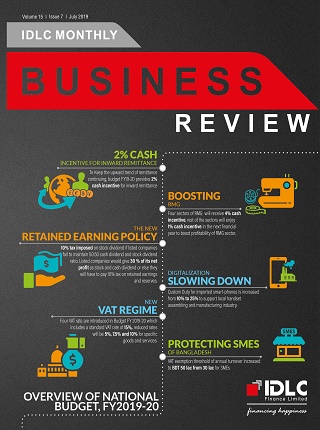The Archive
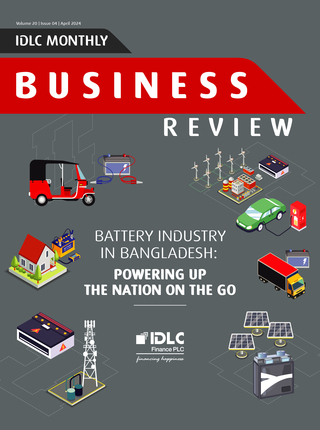
Battery Industry in Bangladesh: Powering Up the Nation on the Go
The lead-acid battery industry, which has grown three to four times in the last decade and is valued at BDT 10,000 crore currently, serves a wide variety of purposes without which portability and mobility would have never been a possibility. Solar panels, easy bikes, battery-run rickshaws, passenger transports, commercial vehicles, IPS, UPS, and telecommunication towers—all these either run on batteries or require batteries as power storage. The fact that the lead-acid battery industry exported around USD 29 million worth of batteries on average in the last five fiscal years makes the industry a potential contributor to our foreign exchange earnings as well.
It is not unknown that the industry faces controversies due to the unregulated manufacturing and recycling operations of some market players. Just like many other industries dependent on imports of raw materials, the rising dollar price has affected the industry adversely. On top of that, the potential emergence of the local lithium battery industry may bring additional challenges. However, policymakers should come forward to create a conducive business environment for this decades-old industry and regularise the unregulated players to minimise the associated environmental and health risks and boost the country’s tax revenues.
Md. Shah Jalal
Editor
IDLC Monthly Business Review
Download View
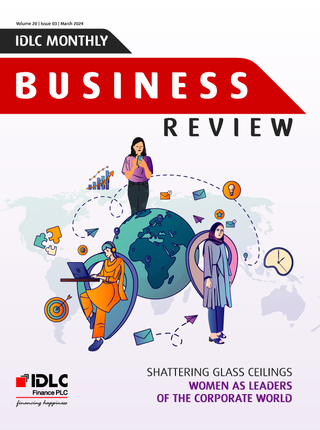
Shattering Glass Ceilings: Women as Leaders of the Corporate World
The corporate landscape of Bangladesh is undergoing a transformation as diversity and inclusion are gaining overdue recognition. Women leaders are making notable strides, challenging traditional gender roles, and securing top positions in renowned corporations. This paradigm shift signifies a crucial step towards a more equitable and progressive work environment where talent and meritocracy prevail over gender biases.
Bangladesh is inching closer to achieving parity in tertiary education, meaning women are no less capable of achieving success in competitive arenas. Translating this gender parity to workplaces is what is required to ensure women's empowerment. However, despite advancements, the gender gap in workplaces remains, with women still underrepresented in decision-making roles. Hence, it's imperative to capitalise on women's capabilities by creating a supportive work culture that harnesses their talents and expertise.
Empowering women has impacts beyond just the corporates. It drives positive economic growth and serves as a beacon of inspiration for future generations. By advocating gender equality and fostering inclusive workplaces, Bangladesh can pave the way for a more prosperous and equitable society where everyone has the opportunity to thrive and succeed.
Md. Shah Jalal
Editor
IDLC Monthly Business Review
Download View
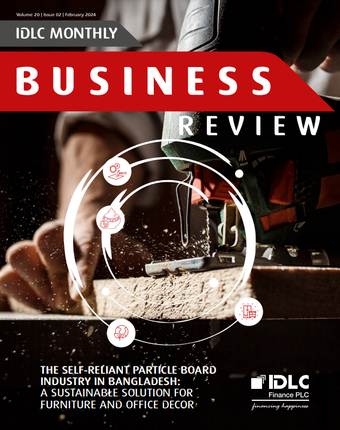
The Self-Reliant Particle Board Industry in Bangladesh: A Sustainable Solution For Furniture And Office Décor
Development in the manufacturing and service industries says a lot about a country’s economic strength. Bangladesh, being a developing country, has a few manufacturing industries in which it has achieved significant value addition and self-sufficiency. The particle board industry is undoubtedly one of them. The abundance of raw materials and cheap labour have fueled the growth of this industry, and the industry has already created a market valued at more than BDT 5,000 crore.
The particle board manufacturing industry started its journey in the country in 1962 by Star Particle Board Mills Ltd., a concern of Partex Star Group. Now, several conglomerates are catering their pie in the industry. It is also noteworthy that the industry has created a conducive environment for small and medium enterprises to grow here. What is unique about the particle board industry is that it promotes sustainability by requiring fewer trees to be cut and recycling waste timber. Though the industry is growing exponentially, it is facing challenges due to the rising dollar price, as adhesives and some other chemicals still need to be imported. Moreover, rising energy costs are a big concern. However, the industry has all the potential to be a contributor to exports if it receives adequate policy support. We can surely expect a sustainable tomorrow with the growth of industries like the particle board industry.
Md. Shah Jalal
Editor
IDLC Monthly Business Review
Download View
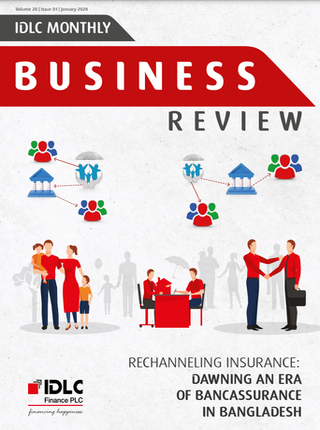
Rechanneling Insurance: Dawning an Era of Bancassurance in Bangladesh
Bancassurance, the strategic collaboration between banks and insurance companies, is set to bolster the largely untapped insurance industry in Bangladesh. Prominent in Europe and some parts of Asia, bancassurance is defined as the symbiotic relationship between banks and insurance companies, where banks receive a commission for opening an avenue for selling insurance policies while insurance companies gain access to a massive network of clients through banking channels. With a penetration rate of a mere 0.5% and a market size of BDT 5,000 crore in Bangladesh, this synergy can serve as a powerful tool for increasing insurance penetration and financial inclusion in Bangladesh.
Developing economies necessitate the demand for insurance, with higher incomes translating to an increased insured population. Gradually, as more and more people avail of insurance policies and bring themselves under insurance channels, the premium size is likely to experience a decline and become affordable to the mass population.
The inadequate claims settlement ratio has held back the insurance penetration rate in Bangladesh to a large extent. Delays in settling claims after policy maturity, insufficient returns due to inadequate fund investment, and financial irregularities pose significant challenges for insurance companies. However, the handshake through bancassurance between banks and insurance companies is expected to foster a conducive environment and bring the uninsured population under the insurance umbrella, resulting in numerous opportunities.
Md. Shah Jalal
Editor
IDLC Monthly Business Review
Download View
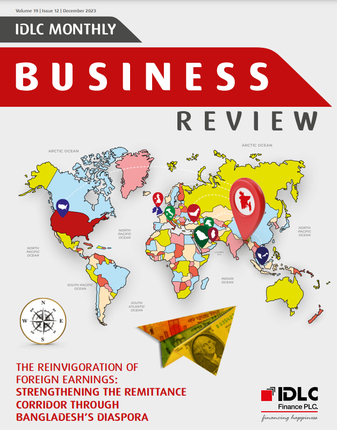
The Reinvigoration of Foreign Earnings: Strengthening the Remittance Corridor through Bangladesh’s Diaspora
Remittances are playing an instrumental role in acting as a catalyst for socio-economic development in Bangladesh. At this critical juncture, with a war-torn world economy and our dwindling foreign exchange reserves, increasing our remittances as a major source of foreign currency reserves is more crucial than ever before. As per the data of KNOMAD via the World Bank, Bangladesh received a substantial amount of USD 21.5 billion in 2022, primarily from migrants in the US, UK, Southeast Asia, and the Middle East, making Bangladesh the seventh highest recipient of remittance globally.
Recent times have brought some unexpected challenges, marked by fluctuating migration patterns and remittance figures. Despite a record 1.136 million migrants last year and 618,000 in the first half of this year, the anticipated increase in remittances did not materialise. Emigrants sent USD 2.199 billion, USD 1.973 billion, and USD 1.599 billion in June, July, and August 2023, respectively, followed by a 41-month low in September (USD 1.343 billion).
Factors such as migrant labour composition, recruitment expenses, and reliance on informal channels all contributed to this fall, prompting government intervention and strategic initiatives. Understanding the underlying mechanisms of the unexpected drop in remittance inflows is critical as Bangladesh strives to revitalise its remittance corridor for long-term growth. To ensure a prosperous future for Bangladesh and its diaspora, a concerted effort involving policy innovation, talent enhancement, and technological integration is required.
Md. Shah Jalal
Editor
IDLC Monthly Business Review
Download View

The Steel Industry Of Bangladesh: Constructing A Compact Foundation Of Growth Amidst Economic Instability
Infrastructural development has taken centre stage in Bangladesh in the last decade, with several ongoing mega projects fueling the significant demand for steel. The industry has flourished largely due to the investment of large conglomerates, diversification of steel products, and enhanced production capacity. According to the World Steel Association, the total consumption of steel was approximately 7.4 million metric tonnes in 2022, while the production capacity of steel mills stood at around 9 million metric tonnes in Bangladesh.
The private sector investment brought a significant overhaul to the steel industry in Bangladesh in the early 1990s. Through a resilient growth pace, the current market size of the steel industry in Bangladesh stands at an estimated BDT 55,000 crore (USD 6.2 billion) as per The Business Standard. Moreover, per capita steel consumption is projected to rise from 45kg in 2022 to over 100kg by 2030, indicating a high growth spectrum. Approximately 60% of the manufactured steel is used in government projects, 25% is used by consumers as per The Business Standard, and the rest 15% is reserved for the private sector.
Though having high growth potential, the steel industry, along with its allied industries, has been grappling with challenges in recent times owing to several critical factors like currency devaluation, high inflation, and a high margin on LC opening. This, in turn, has translated to supply chain disruptions, logistical inefficiency, an energy crisis, and a rise in financing costs. However, the easing of the economic slump would dramatically turn the tide in the steel industry’s favour with the usual resumption of mega projects coupled with government policies. Undoubtedly, the steel industry will play a pivotal role in spearheading the industrial infrastructure in Bangladesh and transforming the country’s economic outlook.
Md. Shah Jalal
Editor
IDLC Monthly Business Review
Download View

Scripting Export Narratives: Leaving A Domestic Paper Trail In Global Markets
Bangladesh is currently in a precarious position due to rising import prices and dwindling foreign currency reserves. Amidst the uncertainties, the paper and paper products industry has emerged as a key source of foreign earnings in recent years, with the sector recording an 85% year-on- year growth during July-August of FY 2023- 24 relative to FY 2022-23.
The market size of paper and paper-allied products is estimated to be BDT 5,000 crore, with the industry comprising diverse paper products, including writing and printing papers, offset papers, newsprints, tissues, and packaging papers. The industry was largely boosted back in 2016, owing to the government’s cash incentive of 10% on receipts. Till now, Bangladesh has been exporting its paper-allied products to over 50 nations, including the United States and countries from Europe, the Middle East, and Africa.
As the world edges closer towards a paperless economy, the demand for writing and printing paper is expected to experience a sharp downfall, while the heavy reliance on paper pulp imports and its scarcity will trigger an increase in the prices of paper products. However, these challenges have been addressed adequately, as paper mills have invested in waste paper processing to reduce reliance on imported raw materials while prioritising product diversification to cater to foreign demands. An excellent opportunity awaits Bangladesh, as the decreased paper manufacturing of China, India and Japan can propel the paper industry to new heights and establish itself as one of the paper manufacturing hubs in the world.
Md. Shah Jalal
Editor
IDLC Monthly Business Review
Download View
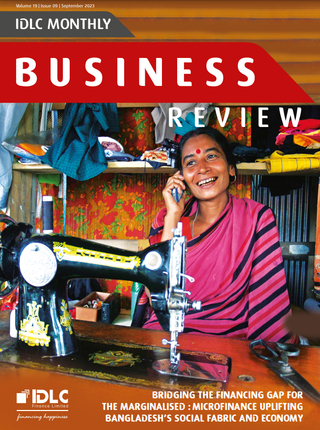
Bridging The Financing Gap For The Marginalised : Microfinance Uplifting Bangladesh’s Social Fabric And Economy
Microfinance has played an instrumental role in enhancing financial inclusion, employment opportunities, and poverty alleviation in Bangladesh. The significant presence of CMSMEs in Bangladesh prompted a rapid rise of microfinance institutions (MFIs) across the country, with 739 MFIs and 23543 branches currently operating under the licence of the Microcredit Regulatory Authority (MRA). During the fiscal year 2021–22, loan disbursements of microfinance reached staggering figures of BDT 226,007 crore, while customer savings stood at BDT 85,036 crore.
The continuous innovation and expansion of microfinance services have facilitated the availability of microcredit and microenterprise loans to the unserved and underserved marginalised community of Bangladesh. The MFIs have flourished in that regard, with annual turnover figures reaching BDT 1.60 trillion while maintaining a near-perfect 98% loan recovery rate, of which 91% of the borrowers are women.
The microfinance sector is met with a fair share of challenges, with high-interest rates and economic shocks largely affecting the financial sustainability of MFIs. Nevertheless, the massive contribution of MFIs towards women’s empowerment, financial inclusion, and poverty reduction has elevated the socio-economic status of Bangladesh and reinforced the belief in the future success of microfinance.
Md. Shah Jalal
Editor
IDLC Monthly Business Review
Download View
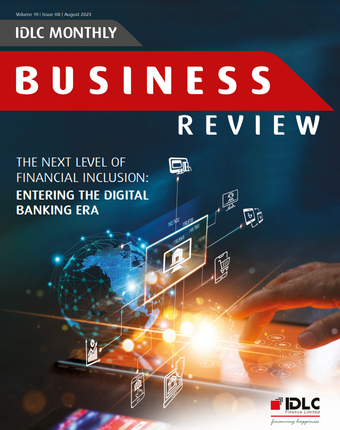
The Next Level of Financial Inclusion: Entering The Digital Banking Era
A revolution in the financial services industry of Bangladesh is in the offing with every passing day, with several banks, MFS, and telecom companies gearing up to invest in digital banks through both individual investments and a consortium. The extension of the digital banking application deadline has prompted almost 20% of the traditional banks in Bangladesh to apply for a digital banking licence in a bid to increase their market penetration and bring the unbanked population under the banking umbrella. With an unbanked population of 47% in Bangladesh, digital banks hold the key to enhancing financial inclusion and extending digital banking services to the underserved and unserved population.
The rapid adoption of MFS and internet banking services has laid the groundwork for digital banks to potentially thrive, as evident by the MFS transactions, which registered a year-on-year growth of 19.5% for April 2023 relative to April 2022. The ease of availing MFS services facilitated the financial inclusion of the unbanked demographic, which mostly consisted of low-income households. The unserved and underserved populations were the biggest beneficiaries of such services, owing to convenience, cost and time savings.
Undeniably, the exponential adoption of MFS among low-income households in the last decade serves as evidence for the potential success of digital banking services. These services can effectively replace conventional banking services, which could lead to more competitive rates and reduced operating costs. This, in turn, can help create a conducive business environment for both banked and unbanked communities where digital banks can accelerate financial inclusion and economic growth of Bangladesh with the vision of bringing the majority of the population under a cashless economy.
Md. Shah Jalal
Editor
IDLC Monthly Business Review
Download View
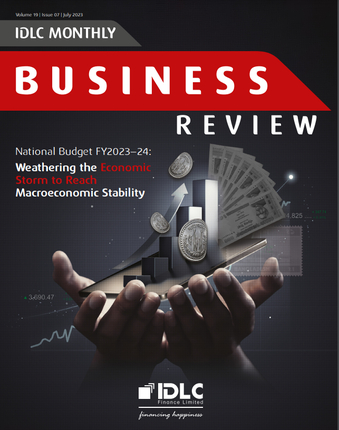
National Budget FY2023–24: Weathering the Economic Storm to Reach Macroeconomic Stability
Economic strife in recent times has led to a downturn in Bangladesh’s GDP growth owing to high inflation, slow growth in the private sector, and minimal growth in remittances. In a bid to reach macroeconomic stability, a national budget of BDT 7,61,785 crore was announced for the fiscal year 2023–24, with the budget comprising 15.2% of the GDP. The GDP growth rate has been targeted to reach 7.5%, while the annual inflation rate is expected to be 6% for FY 2023–24.
Meanwhile, Bangladesh Bank (BB) released a monetary policy statement (MPS) on June 18 with contractionary measures underlining the central bank’s objectives in curbing inflation. Many countries adopted a similar approach, with the United States, India, Thailand, and the European Union successfully managing to curtail their inflation significantly through demand reduction strategies.
As pointed out by economists, restoring macroeconomic stability remains pivotal for Bangladesh to bring some much-needed respite to the economy. Effective approaches to achieving the aforementioned target include the coordination of exchange rate, monetary, and fiscal policies to strengthen exports, curb inflationary pressure, increase tax revenues, and reduce fiscal deficits. With timely measures taken by BB to combat inflation through its contractionary monetary policy, economists and business leaders are hoping that both fiscal and monetary authorities work in tandem to reduce inflation significantly in the country. This will pave the way for Bangladesh to reach macroeconomic stability for future economic prosperity and continue the long journey towards a developed country by 2041.
Md. Shah Jalal
Editor
IDLC Monthly Business Review
Download View

Shades of Brilliance: A Deep Dive into the Paints & Coatings Industry of Bangladesh
The paints and coatings industry has consistently registered an annual growth rate of 6% owing to significant industrialisation, urbanisation, and economic development in Bangladesh. Synonymous with the beautification of structures, it also plays a crucial role in increasing longevity as well as protecting important infrastructure. As reported by Statista, a leading statistics portal based in Germany, the global market size of the paints and coatings industry was estimated to be USD 160 billion in 2021, and it is forecasted to reach USD 235 billion by 2029.
Generating a yearly revenue of around BDT 7 billion for Bangladesh, the sector currently employs over 100,000 individuals. The industry is largely dominated by multinational companies, with the lion’s share of the USD 471 million market size in Bangladesh, as per a global information source named Coatings World. An increase in per capita income coupled with rising consumption patterns in both urban and rural areas has given this sector a thrust to build on its already promising growth.
Increasing prices of raw materials in international markets and the depreciation of local currency have recently impeded the industry’s upward trajectory to a large extent. Despite the global economic turbulence, the industry can experience a sharp increase in the coming years through infrastructural development and the growing automotive and construction sectors. Certainly, economic recovery can help the industry rebound to its previous levels of growth and grow in stature in the future.
Md. Shah Jalal
Editor
IDLC Monthly Business Review
Download View
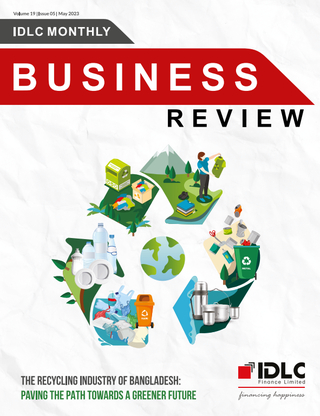
The Recycling Industry of Bangladesh: Paving the Path towards a Greener Future
Waste generation has risen to alarming levels in recent years, with the World Bank reporting that the figure is expected to reach almost 3.88 billion metric tonnes by 2050. Population growth, the rapid urbanisation rate, economic expansion, and consumers’ indiscriminate consumption patterns are deemed to be the key reasons behind this ever-increasing waste generation. The state of our environment is a dire concern owing to the existing linear economic system (take-make-waste), and one of the most effective ways to combat this crisis is by championing the cause of recycling.
The rise in purchasing power of people in Bangladesh has led to increased consumption, eventually resulting in large-scale waste generation. Moreover, the informal recycling process is hindering the country’s efficient waste management, preventing Bangladesh from recognising its true potential in the recycling industry. However, adopting a circular economy, the alternative to the linear economic system, through waste elimination and replenishment of natural resources can not only unlock avenues for revenue streams but also pave the way for a greener future.
In a world of limited resources, recycling offers a beacon of hope and a tangible solution to mitigate the damage we have inflicted on our environment. By implementing a proper recycling process, Bangladesh can bolster its economic and environmental landscape by generating employment opportunities, promoting economic growth, and preserving natural resources.
Md. Shah Jalal
Editor
IDLC Monthly Business Review
Download View
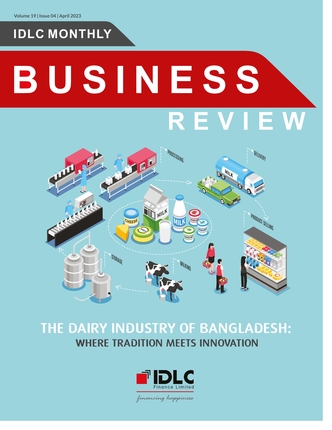
The Dairy Industry Of Bangladesh: Where Tradition Meets Innovation
The dairy industry has maintained a strong foothold as a promising sector in Bangladesh. Since the early stages, the industry has undergone massive development, as evident by its enormous market size at present, which is estimated at USD 2.47 billion by the Department of Livestock Services. Despite registering steady growth in the production of milk, the industry is still heavily reliant on importing milk to meet local demands.
In recent years, the industry has integrated modern technologies into dairy farming, with innovation now playing a key role in maximising milk production. Automation in dairy farming has enhanced the collection, processing, and production of milk, leading to economies of scale and minimising costs. Artificial insemination is helping to extract 225% more litres of milk from cow breeds in comparison with traditional farming. Additionally, leading industrial processors are diversifying their product offerings by offering variations of milk derivatives.
Though the industry has several hurdles to overcome, incorporating cutting-edge technologies with traditional practices will promote growth, increase production, and facilitate product diversity to meet changing consumer preferences. As the government aims to be self-sufficient in meeting domestic demand by the year 2030, encouraging innovation will be instrumental in reducing the import gap and boosting the dairy industry.
Md. Shah Jalal
Editor
IDLC Monthly Business Review
Download View
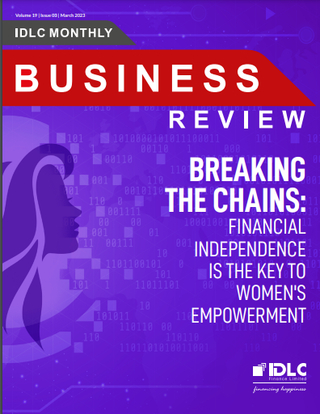
Breaking the Chains: Financial Independence is the Key to Women’s Empowerment
Financial independence is a crucial aspect of women’s empowerment because it enables women to take charge of their lives and make well-informed choices to build a better future for themselves as well as for their families, society, and the country at large. Research from the McKinsey Global Institute shows that the global GDP could grow by USD 12 trillion by 2025 if gender gaps are closed and women are given more economic power.
Women have been deprived of equal access to opportunities as their male counterparts throughout history. Despite comprising 60% of the workforce in the RMG industry of Bangladesh, the dearth of women at the industry’s management level is leading to gender inequality and poor work culture. The gender pay gap has left women with little savings and investments for the future, making them more exposed to economic instability.
Notwithstanding numerous hurdles, women in Bangladesh have made significant progress in recent years in climbing the corporate ladder and gaining leading positions. They have continually broken through boundaries and challenged societal norms. Bangladesh can pave the road to a more equitable and prosperous future for everybody by recognising the value of women’s contributions to the economy and society and giving them equal chances.
Md. Shah Jalal
Editor
IDLC Monthly Business Review
Download View
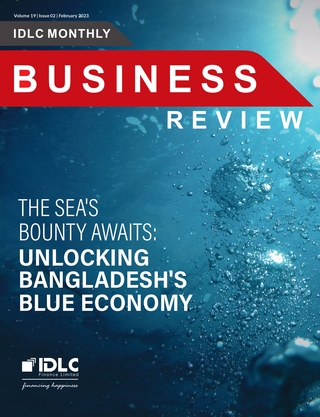
The Sea's Bounty Awaits: Unlocking Bangladesh's Blue Economy
The blue economy concept has become an exhortation for sustainable development through the utilisation of ocean resources for economic growth, enhanced livelihoods, and employment while conserving the health of the environment. According to the United Nations (UN), the industry is worth between USD 3 and USD 6 trillion globally, with its strong ties to SDG-14 (Life Below Water) serving as a crucial reason for elevating this sector.
With around 710 kilometres of coastline, the blue economy offers numerous opportunities for Bangladesh, particularly in the sectors of fisheries, shipping, tourism, natural resources, and oil and gas. The blue economy has the potential to make a substantial contribution to economic growth and enhance the quality of life for the people residing in Bangladesh’s coastal regions.
Expanding ocean-centric industries will bring a new perspective to our economic prosperity. At the same time, the unplanned proliferation of economic activities will be the cause of marine ecosystem deterioration and biodiversity loss, causing significant harm to low-income coastal residents. Understanding and effectively managing the numerous facets of marine sustainability is crucial to reaping the sea’s bounty.
Md. Shah Jalal
Editor
IDLC Monthly Business Review
Download View
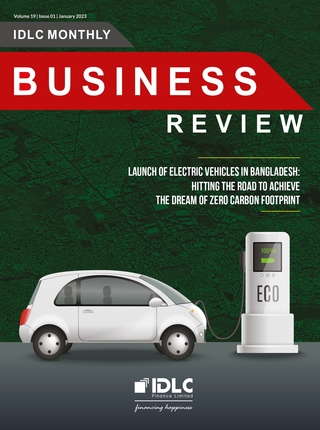
Launch of Electric Vehicles in Bangladesh: Hitting the Road to Achieve the Dream of Zero Carbon Footprint
Despite being an integral component of our daily life, transportation accounts for 37% of the world’s carbon dioxide emissions due to its heavy reliance on fossil fuels. However, people are inclined towards electric vehicles (EVs), as reflected in a recent study, which shows EVs account for 8.57% of total automobile sales in 2021 globally, demonstrating the exponential growth potential of the electric vehicle sector.
The electric car industry in Bangladesh is on the rise, as growth of 154% in hybrid car imports from 3,296 units in FY18 to 8,366 units in FY21 has been observed. Increased fuel prices and lower maintenance costs have driven the increase in sales. This adoption has enabled new ventures and start-ups to focus on developing locally manufactured EVs.
Few to no charging hubs, high import duties and misconceptions around the EV currently stand as a roadblock to the bright prospects of this industry. However, it shows promise as the government progresses towards “Vision 2041,” which will enable electric vehicles to run the streets of Bangladesh in full swing.
Md. Shah Jalal
Editor
IDLC Monthly Business Review
Download View

CASHLESS ECONOMY: THE NEXT STEP OF DIGITAL BANGLADESH
Bangladesh is undergoing an unprecedented transformation in the way it conducts its financial transactions. With the rapid digitisation of the economy, cashless transactions are becoming increasingly popular. Recent data from Bangladesh Bank (BB) states that more than BDT 3,000 crore is being transacted through mobile financial services (MFS). Even the use of plastic money has increased exponentially, as is evident by the 24% rise in credit card debt over previous years.
This shift towards cashless or digital payments is driven by several factors, including the government’s goal of becoming a “Digital Bangladesh,” the increasing availability of digital banking services, and the growth of mobile money and e-commerce platforms. The FinTech industry is venturing more and more into cashless payment and transaction integration systems. As a result, the number of cashless transactions in Bangladesh is rapidly growing, and the country is on track to become a leader in digital payments in the region. Nevertheless, some critical issues need to be addressed to transform the country into a cashless economy.
Md. Shah Jalal
Assistant Manager
IDLC Finance Limited
Download View

CERAMICS INDUSTRY IN BANGLADESH: RISING AMIDST CHALLENGES
With a total market value of over 6,000 crores, the ceramics industry in Bangladesh has been one of the country’s fastest-growing manufacturing industries. Thanks to sustained economic growth and increasing urbanisation, the industry meets 85% of domestic demand and has the potential to become the country’s largest export industry in the not-toodistant future. With domestic sales increasing by 20% per year on average, export sales increasing by 26% per year on average in the last three years, and total production capacity increasing by around 200% in the last five years, the industry is poised for future success.
The industry benefits from rising incomes, rapid urbanisation, and duty-free access to some international markets. There is still much to be done to address the problems this industry is facing, such as uninterrupted power and gas supplies, which are essential to continue competing in global markets. If Bangladesh’s ceramics sector can get over the obstacles, it has every chance to develop and increase its contribution to the nation’s foreign exchange earnings. It stands to see what the future holds for this industry.
Md. Shah Jalal
Assistant Manager
IDLC Finance Limited
Download View

Pharmaceutical Industry in Bangladesh: The Next Export Frontier
The pharmaceutical industry, with a market value of more than BDT 275 billion, is one of Bangladesh’s fastest-growing industries, with leading companies like Square Pharmaceuticals Limited, Incepta Pharmaceuticals Limited, Beximco Pharmaceuticals Limited, and Renata Limited.
Download
View
CONSUMER ELECTRONICS INDUSTRY IN BANGLADESH: A SHIFT TOWARDS PERSONALISED EXPERIENCE
With a market value of BDT 20,000 crore, the consumer electronics sector is one of Bangladesh’s fastest-growing industries, with the majority of the product categories entirely import-dependent, although local companies are on the rise.With consumer preference for these foreign brands ever-increasing due to their ability to provide more reliable services, only a handful of local companies are able to cater to these needs. Despite the dependency on foreign brands, increased domestic production sparked a boom, as companies like Walton started exporting thanks to government initiatives. However, some policy contradictions require consistency in implementation. A big success factor of local companies is their ability to embrace innovation through the adoption of technology and integrate existing processes to deliver to customers a greater value proposition through a personalised experience. The result is that customers benefit from brand atomisation, which means relying less on foreign brands as well as greater availability of consumer data flow through various interaction points.With consumers demanding more convenience and innovative technologies, this will be the biggest challenge for local brands’ survival in the days to come, along with rising dollar prices and inflation, as they compete for these features with foreign brands as well.
Md. Shah Jalal
Assistant Manager
IDLC Finance Limited
Download View
FLOUR MILLING INDUSTRY IN BANGLADESH: FLOURISHING THROUGH AUTOMATION
Bangladesh is mainly a rice-consuming country, but flour is the second most important staple food in Bangladesh after rice, meaning flour is a crucial part of our national food security. Hence, flour milling plays a significant role in ensuring food sufficiency in Bangladesh. Though it started with a traditional milling process called “chakki”, now the industry is flourishing through automation.
According to the Bangladesh Bureau of Statistics Household Income and Expenditure Survey (HIES, 2005–2016), daily per capita wheat consumption was 12.08 g in 2005 and 19.83 g in 2016. This growing consumption pattern implies a higher demand for flour in Bangladesh. Moreover, urbanisation, the increasing popularity of fast food, and changing lifestyles have all increased the demand for flour over the years. In recent years, many fast-moving consumer goods (FMCG) companies have started exporting flour-based products, like bakery goods, in addition to serving the domestic market. One of the major challenges faced by the industry is high import dependency. Russia and Ukraine produce 30% of the world’s wheat. These two nations provide 40% of Bangladesh’s wheat imports. Shockingly, the current war between Russia and Ukraine has had a destabilising effect on the country’s wheat supply, causing price volatility and uncertainty. Clearly, the future of wheat and flour milling in Bangladesh depends on trade wars, agriculture policy, and the use of modern technologies.
The flour milling industry in Bangladesh has to become more productive by adopting efficient business models. Most i
Download
View
ISLAMIC FINANCE IN BANGLADESH: EN ROUTE TO NEW HORIZONS
Islamic finance, which adheres to Shariah principles, is one of the thriving segments of the global financial system. A recent report published by Refinitiv, one of the world’s largest providers of financial market data and infrastructure, postulates that the size of the Islamic finance industry is expected to grow from USD 3.37 trillion in 2020 to USD 4.94 trillion in 2025, representing an annual growth rate of 8% on average over the course of the next five years.
Bangladesh is one of the fastest-growing economies in the world. In line with other economic activities, Islamic finance in Bangladesh has also been witnessing robust growth. The country is among the top ten economies holding the highest Islamic financial assets and is growing above the global average growth rate.
Out of the USD 50 billion Islamic finance market, Islamic banking alone possesses a market cap of USD 48 billion, which indicates that the Islamic capital market, the Islamic insurance (Takaful) market and other areas of Islamic finance have not flourished to the extent of Islamic banking expansion in Bangladesh. Nonetheless, the recent issuance of Sukuk (Islamic bond) by both the public and private sectors, the gradual development of the Takaful market (Islamic Insurance), the penetration of Islamic microfinance to the doorsteps of marginalised people, and the advent of Islamic FinTechs indicate that other areas of Islamic finance have a bright future.
Considering the high market demand and growth potential of Islamic finance in Bangladesh, different financial institutions are trying to offer innovative Islamic financial products and services to their clients. Undoubtedly, this growth momentum of Islamic finance indicates that our financial ecosystem is en route to new horizons.
Md. Shah Jalal
Assistant Manager
IDLC Finance Ltd.
Download View
Mobile Phone Manufacturing Industry: Another ‘Made in Bangladesh’ Success Story
The invention of the mobile phone and mobile technology was groundbreaking. One gadget with so many capabilities is transforming the world by placing everything in the palm of our hands.
China, Vietnam, and India are the world’s leading manufacturers of mobile phones. Bangladesh joined those ranks through the hands of local tech giant Walton Group in 2017. Also, world-renowned companies like Samsung, Nokia, Vivo, and Xiaomi have started assembling and manufacturing operations locally in recent years.
Because of the government’s supportive fiscal policy throughout the journey, the mobile phone manufacturing and assembling industry, which began in 2017, is now capable of meeting more than 80% of local market demand. Furthermore, the industry is showing enormous export potential.
Howbeit, the mobile phone manufacturing industry seems to have high growth potential; the industry is facing a branch of challenges, i.e., import dependency for key components of mobile phones, lack of strong R & D facilities, and trading of unofficial handsets, etc. In addition to that, it has been proposed in the budget for the fiscal year 2022–23 to withdraw the existing 5% VAT exemption at the trading stage of mobile phone sets, which will affect the affordability of mobile phones consumers in Bangladesh.
Even after being faced with multiple challenges, it is undeniable that Bangladesh is the 9th largest mobile device market globally. The thriving mobile phone manufacturing industry in Bangladesh has almost all the right things going for it for another “Made in Bangladesh” dream to come true.
Md. Shah Jalal
Assistant Manager
IDLC Finance Ltd.
Download View
EdTech in Bangladesh: A Revolution in the Offing
EdTech in Bangladesh: A Revolution in the Offing
FROM THE EDITOR
In March 2020, the global Coronavirus pandemic resulted in shutdown of classrooms. Teachers and students opted for online classes in order to save academic years for millions of students across the country. EdTech start-ups such as 10 Minute School, Shikho, Shohopathi, which provided online platform for learning, started to thrive from that period of time. Funding in the EdTech industry which was around 0.16 mln in 2018 climbed to around 6 mln in 2022 and 89% of it is foreign funding. According to The Business Standard, 10 Minute School achieved 12 times growth in 2021 with 3.20 mln application users and the amazing part is that, majority of the application users are rural learners. Meanwhile, Shikho which is the country’s largest seed-funded start-up has its paid application users growing by around 140% since its inception. Needless to say, hence, a revolution in the EdTech industry is indeed in the offing. However, factors such as better internet connectivity across the country, greater and cheaper access to hand-held smart devices, more world-class education accreditation for online platforms, etc. should be addressed, to make the growth of this industry sustainable.
RIFAT ISHTIAQ KHAN
Manager
IDLC Finance Ltd.
Download View
Jute Industry of Bangladesh: Reclaiming the Lost Glory
Jute Industry of Bangladesh: Reclaiming the Lost Glory
FROM THE EDITOR
On March 6th, 2022, the country observed National Jute Day. The Ministry of Textile and Jute celebrated this day with the slogan ‘Sonali Asher Sonar Desh, Paribesh Bandhab Bangladesh’. Although this industry has lost much of its glory off late, as it has been battered by factors such as lack of diversification, inadequate local demand, mismanagement, corruption, etc., jute, which was synonymously referred as ‘the golden fiber’ is still the second export earning sector next to RMG. The sector has an average contribution of 3% in our export earnings and 1% in GDP. The demand for high-tech jute goods across the globe is huge and at times when the world environmentalists are echoing for environmental sustainability, jute can be a potential game-changer for our economy, if the industry can flourish to its potential. The jute industry of Bangladesh will get its glorious days back, if right focus and government support is given to this industry.
RIFAT ISHTIAQ KHAN
Manager
IDLC Finance Ltd.
Download View
Women in Tech Industry: Gender Equality, the Need of the Hour
We are witnessing an exciting tech-fuelled era which was dreamt of for decades. In times such as these, when the tech industry landscape is rapidly transforming the world, women are still struggling to secure their places in this industry. But, according to various reports, it is evident that diverse companies perform better, hire better talents, have more engaged employees, and retain workers better than companies that do not focus on diversity and inclusion.
Reports suggest that 25% female students studying at tertiary levels in Bangladesh enroll for Computer Science (CS) or Information Communication Technology (ICT), while 13% of them end up joining the ICT industry after completing their graduation in the related subjects.
The lack of women taking up tech-related degrees (STEM subjects) translates into the workforce, where at many tech companies, males form the overwhelming majority. This eventually leads to women experiencing prejudice and feeling like they do not belong. It is time we focus on the next generation of tech talents and make sure gender equality exists for the betterment of everyone. This means more flexible working arrangements, more women in leadership roles and more encouragement at an early age for girls and boys to chase whatever they are naturally interested in.
RIFAT ISHTIAQ KHAN
Manager
IDLC Finance Ltd
Download View
Supply Chain Finance: Optimizing Financial Flows in Bangladesh
SUPPLY CHAIN FINANCE: Optimizing financial flows in Bangladesh
Supply chain finance is deemed as a win-win opportunity for all stakeholders in the supply chain ecosystem- the corporates, their suppliers and the factor. Rather than waiting on its large customers to pay invoices, the supplier can submit invoices to financiers for early payment. In turn, this provides immediate access to liquidity which can help the supplier keep operating in a “business as usual” environment in any business climate. These along with factors such as proper fund utilization, authenticity of cash flows of borrowers, etc. have garnered much popularity in the country for this particular financing vehicle.
IDLC Finance Limited pioneered and introduced supply chain finance in 1999. Despite its commencement 23 year back, this particular segment of finance is yet to live up to its potential. The clear concept of supply chain finance is still absent among customers in our country. Additionally, the corporate buyers lack interest in supporting their suppliers and as a result, the suppliers end up availing loans at a high rate.
From regulatory point of view, Bangladesh does not have any specific policy guideline or legal framework for supply chain finance. Nor there is any legal framework for the security of the payment for these products. Hence, for this segment to thrive, the driving force needs to come at policy levels. Meanwhile, corporate buyers have to come ahead and support their suppliers by means of reverse factoring.
RIFAT ISHTIAQ KHAN
Manager
IDLC Finance Ltd
Download View
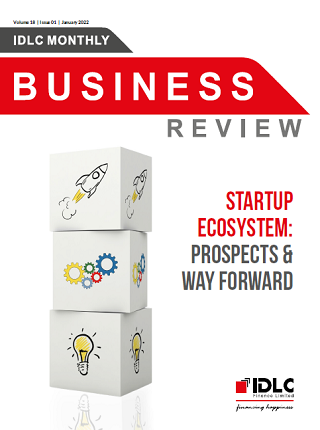
Startup Ecosystem: Prospects & Way Forward
Startup Ecosystem: Prospects & Way Forward
Growth in traditional drivers such as RMG, Agriculture, etc. along with pragmatic economic policies of the government have catalysed the tremendous growth of startup ecosystem in Bangladesh. Needless to say, 2021 was a year of recovery and progress for startups as Global Pandemic fasttracked technology adoption across various segments and the country got its first ever Unicorn, a Startup which has valuation of more than USD 1 bln, in Bkash.
In 2021, startups had raised USD 166 mln of total fund which was only USD 40 mln in 2020. Like most emerging markets, the growth of this ecosystem in the coming years is expected to be aligned with growth of E-commerce, logistics and payments segments. These sectors along with ridesharing, delivery solutions & consumer services attracted the deserving attention from foreign investors. Health-care, Foodtech and Education sectors also witnessed notable growth. Appreciatively, Bangladesh government also launched its own Startup Bangladesh, which is a USD 11.5 mln fund to support startups. It has already invested around USD 11.1 mln in 50 startups.
Startup Ecosystem in Bangladesh offers lucrative landscape of untapped opportunities. Remarkable growth can still be obtained in this ecosystem, if major segments such as garments, wealth management, insurance, micro financing, etc. can be addressed. Proper infrastructure, process and guidelines tailor-made for the Incubators, Venture Capitals and Angel Networks would encourage more investments. Resultantly, it would pave way for more global investors such as Tiger Global, Sequoia and Softbank, in the years to come.
RIFAT ISHTIAQ KHAN
Manager
IDLC Finance Ltd
Download View

HOUSING MARKET: RISING CONSTRUCTION MATERIAL PRICES AND ITS IMPACT
HOUSING MARKET: RISING CONSTRUCTION MATERIAL PRICES & ITS IMPACT
For a country such as Bangladesh which is ever growing in terms of population and GDP, meeting housing needs as per demand was always a challenge. In such perilous situation when housing supply was struggling to keep pace with the rapid urban growth, pandemic happened. Now, as the economy crawls back to normalcy amid the coronavirus pandemic, the surging prices of building materials is threatening the country’s housing market.
Cost of almost all the construction materials such as steel, cement, coal, and stone increased significantly owing to factors such as increase of freight charges, hike in fuel price, unavailability of cargo ship, etc. This has led to increase in the construction costs (which comprise of around 50% of any overall project), by around 20% and this upward trend of cost is expected to sustain till mid-2022. The cost of mega construction projects undertaken by the government such as Padma Bridge and Elenga Road Project has increased multiple folds due to surging material prices. It has also left many developers unsure about their future residential and commercial projects. Contractors of development projects are now hesitant to bid for their new projects and are demanding price adjustments for their ongoing projects.
The housing market, however, is in its phase of rebound, thanks to certain government policies such as lower interest rates cap for banks, reduction of registration fees, etc. Along with this, recovery of the overall economy will surely make this industry come back strongly.
RIFAT ISHTIAQ KHAN
Manager
IDLC Finance Ltd.
Download View
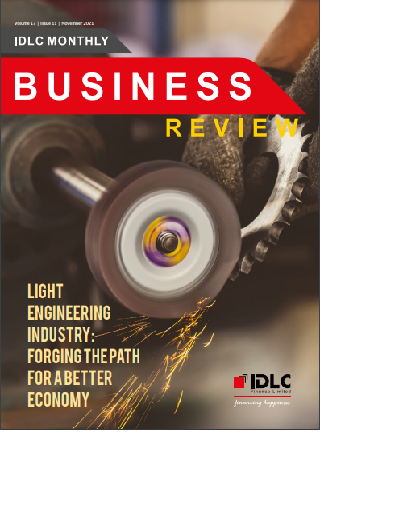
LIGHT ENGINEERING INDUSTRY: FORGING THE PATH FOR A BETTER ECONOMY
Light Engineering Industry: Forging the Path for a Better Economy
Bangladesh is witnessing promising growth of Light Engineering Industry (LEI) which has contributed 2% of overall GDP and has the potential to further boost the country’s overall export diversity. Our country has become a major player in the global apparels industry but export performance of Light Engineering Industry (LEI) has decreased by 14% in 2019-20 in comparison to the previous year. However, the government has taken some initiatives like deciding to set up 10 dedicated light engineering parks which will surely help this sector rebound in terms of export performance.
This industry which provides backward linkage of raw material support to almost all manufacturing sectors, continues to grow each year and produces a diverse range of products. Initially, light engineering enterprises emerged from the Dholaikhal and Jinjira areas in Dhaka. However, with time, different types of light engineering enterprises have spread all across the country.
Despite being an important sector in the country, the LEI continues to face a plethora of challenges including shortage of workers, lack of quality raw materials, modern technologies, access to finance, industrial facilities and policy support, etc. The LEI can help poverty alleviation by generating employment and increasing contribution to the GDP. Therefore, timely implementation and review of government policies for this sector should be carried out to help this sector overcome its major obstacles and grow to its optimum level.
RIFAT ISHTIAQ KHAN
Manager
IDLC Finance Ltd.
Download View
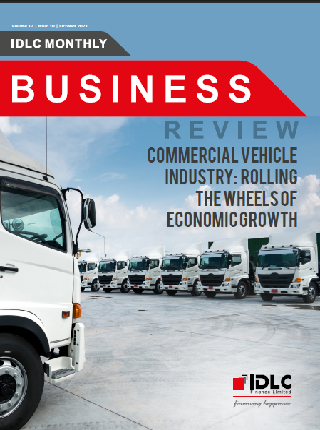
COMMERCIAL VEHICLE : ROLLING THE WHEELS OF ECONOMIC GROWTH
Commercial Vehicle Industry: Rolling the Wheels of Economic Growth
With the expansion of the manufacturing sector in our country, the demand for the commercial vehicles is on the rise than ever. Manufacturers of various goods and logistics companies are the end customers of commercial vehicles, as they require transportations to deliver goods to various points all over the country. Due to the countrywide shutdown, the industry suffered from negative growth for the first time in the last few years. However, the pandemic-stricken economy is reviving in tandem with the recovery of the commercial vehicle industry.
GDP of Bangladesh is projected to reach 340 billion USD in 2022. Keeping pace with that, the commercial vehicle industry is expanding by 15% to 20% every year. Fast track projects undertaken by the government to develop the roads and highways of the country are helping to sustain the growth. Technological advancements have touched this sector as well like many other sectors. Resultantly, technologies like GPS and smartphone apps like Truck Lagbe, GIM, Loop Freight etc. have already become widely available to city dwellers and have positively impacted the industry.
Needless to say that the success of trade and commerce of a country largely depends on its well-structured transportation system. Keeping that in mind, the government in collaboration with foreign investors is patronizing local assembly with the goal to manufacture commercial vehicles with locally sourced materials.
Like every other industry, this industry is also going through some major challenges. Congested traffic, unsafe roads, poorly trained drivers, high import duty etc. are some of major challenges that must be mentioned. Government initiative to formulate industry-friendly policies and proper implementation of them is highly required to help this potential industry flourish.
RIFAT ISHTIAQ KHAN
Manager
IDLC Finance Ltd.
Download View
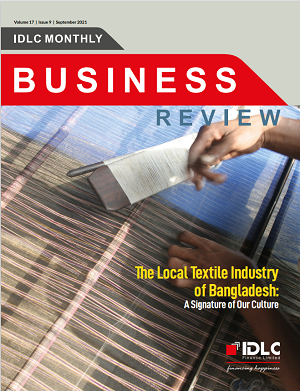
The Local Textile Industry of Bangladesh: A Signature of Our Culture
The Local Textile Industry of Bangladesh: A Signature of Our Culture
Clothing is one of the basic needs of human life for survival that comes after food but it is more than an essential requirement as it represents the uniqueness
and identity of a nation. We have represented our heritage in the global stage through Jamdani and Moslin. With passage of time, our concentration moved
towards the RMG and we, through leveraging our competitive advantage of low cost production, have secured the third position in the world.
Although it is very common to associate the RMG sector with local textile industry, RMG is different from local textile. RMG sector is engaged in manufacturing
export oriented products while the local textile holds the aim to serve the native demand.
The local textile has to go through five distinctive steps to produce the finished goods. The process starts from import of cotton, and then we move to spinning which means the production of yarn. After producing yarn we move to the next step and it is weaving where grey fabrics are produced. Then we move to the fourth step where grey fabrics move into dyeing and printing factories and finally, we step into the final stair and it is the finished goods.
The size of local textile industry is immense and its market size is of USD 7 billion dollar. Although there is a trend of duplicating the design of neighboring
countries but our local brands, for example: Yellow, Sailor, Aarong, etc. are promising and we hope that in the near future we will cater our domestic market with own distinctiveness.
Nothing is beyond challenges and limitations, and our local textile industry also has certain challenges which range from scarcity of investment to reform of existing policies. Yet, we can see a prospective future of this sector, and proper nurture of this segment will let us set our footprint in abroad as well, after fulfilling the domestic demand.
RIFAT ISHTIAQ KHAN
Manager
IDLC Finance Ltd.
Download View
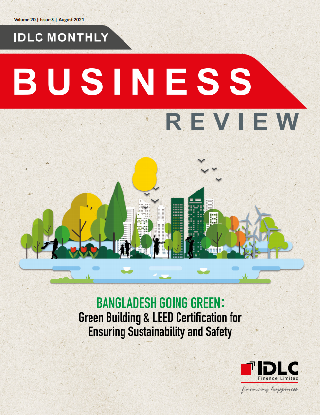
BANGLADESH GOING GREEN: GREEN BUILDING & LEED CERTIFICATION FOR ENSURING SUSTAINABILITY AND SAFETY
Green Building and LEED Certification: One of the many attempts to ensure sustainability in Bangladesh.
The spiraling concern for saving the environment and its resources has led many platforms to opt for the green building strategy, which takes into account
the environmental factors and efficient distribution of limited resources. Bangladesh has also stepped up in the initiative of Green building strategy, and at present Plummy Fashions, of Bangladesh, is thegreenest knit apparel factory in the world awarded by USGBC ( U.S. Green Building Council). Amongst the
numerous Green Building rating systems available, LEED certification is the most widely used rating system worldwide, as well as in Bangladesh.
Leadership in Energy and Environmental Design (LEED) has 110 credits in total, and consists of 4 levels of certification for industries, offices, retails, residential, and other building projects. LEED Certified buildings are on the rise globally, with the USA occupying the leading position in terms of projects and space. The LEED Certification process consists of four simple steps, starting with registering for a project online through their website.
Within a short time, the number of LEED-certified projects has risen above 160 in Bangladesh, this has led multiple banks and NBFIs, including Bangladesh
Bank, to come up with several financing schemes to help finance the green construction projects. Besides these, Green Transformation Fund and SREUP Financing Scheme (Program to Support Safety Retrofits and Environmental Upgrades in the Bangladeshi Ready-Made Garments Sector) have also come up with initiatives, specific to the RMG industry, to finance green building. Thus, these initiatives have allowed many clients to benefit from the low-cost funds.
With the availability of more funding options and awareness, there can be an upsurge in the number of green building projects in Bangladesh. With climate
change being one of the most heated issues in the contemporary world, it is time to train more experts in this field so that the new generation of professionals will understand the significance of the issue.
Bonnishikha Chowdhury
Executive Officer
IDLC Finance Limited
Download View
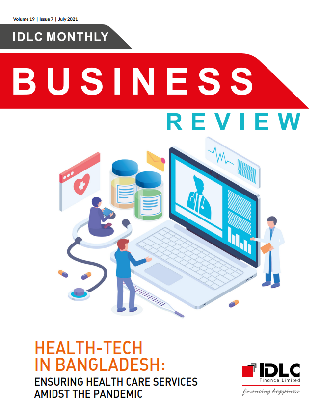
HEALTH-TECH IN BANGLADESH: ENSURING HEALTH CARE SERVICES AMIDST THE PANDEMIC
Health-tech in Bangladesh: Safeguarding the country’s health care sector with constant improvement
With the vision of Digital Bangladesh, the nation has set its foot on the path of digitization. Last year when the entire country saw an influx of Covid-19 cases, e-health allowed healthcare to reach the households of Bangladesh allowing patients to receive quality health services in the palm of their hands by ensuring
safety measures. Initiatives were taken in the past to establish e-health services in Bangladesh, however, due to lack of technological advancement imperceptible advancement were made. At present with a significant amount of the population having access to mobile phones and the internet has made the availability of e-health services feasible.
Exploiting the blessing of artificial intelligence several new health-tech platforms have emerged in Bangladesh. These platforms are not only standing by the side of the Covid-19 affected patients but also with patients who are afraid of visiting doctors for other health-related issues during the pandemic. Starting from helping patients with mental health issues, to connecting patients with their desired doctors who can provide them with online consultations, to providing medicines at the patients’ doorsteps and providing pharmacies in remote areas with the required medical supplies, to providing diagnostic test services at home, all of these have been successfully implemented in Bangladesh, by the youth over the past few years.
The government has not been sitting behind in exploiting technology for health care, countless approaches were initiated by the government in order to reach out to the patients. Online portals have been established to keep the people updated with the latest Covid news, chatbots are delivering health services by extracting information from health experts of renowned organizations. Awareness is being spread to each citizen by the means of social media. Similar approaches like Bangladesh have also been taken by our neighbors India, Pakistan, and Nepal. While the city dwellers are benefitting from all the advancements, the rural poor are still being a victim of the digital divide. Even though several approaches have been initiated in the rural areas, they still have a long way to go.
As Bangladesh is still on its way towards digital Bangladesh, countless bridges need to be constructed in order to fill in the gap in the fractured healthcare
system. According to experts, the emerging e-health platform provides a path for the socio-economic development of the country. Hence, with proper utilization of resources, the country will be able to level up the health care sector, especially in the rural areas.
Bonnishikha Chowdhury
Executive Officer
IDLC Finance Limited
Download View

REAL ESTATE SECTOR OF BANGLADESH: COVID 19 AND ITS AFTERMATH
Real estate sector: Thriving against all odds since its inception
The real estate sector of Bangladesh started its journey in the 1970s, with the concept of developing apartments, and has been climbing up the ladder ever since. At present, developing apartments has stretched to model cities, shopping malls, and commercial set-ups making the sector one of the key drivers of economic growth. The sector has managed to make a sizable impact in employment generation and directly adds on average nearly BDT 5.0 million to government revenue per annum.
The spiraling growth in population has made Dhaka and Chittagong into two of the most populous metropolitan cities in Bangladesh, for which they attract most of the projects. Bangladesh Bank estimates the housing finance demand for the fiscal year 2020-21 to rise compared to that of the previous year, with private banks holding the lions share in outstanding housing loans as of end of June 2020. The nationwide lockdown last year, acted as an obstacle to the growth of this sector, from which it is gradually recovering because of the enormous support from the government. Moreover, high liquidity which drove the lower interest rate in the banking sector also played a vital role here.
Many doors have opened for the booming real estate sector, for example, the development of new and spacious areas outside of Dhaka which calls for urban infrastructures in order to develop.The construction of new roads and railways will provide them with an opportunity to consider regions apart from the mainstream ones. The increasing rate of lower-middle-class people has led to a rise in demand for their homes. In addition to that as mentioned above support from the government, banks and NBFIs are also contributing immensely.
Unfortunately, the pandemic is not the only hurdle faced by the real estate. Mismanagement caused by few developers sometimes result in customer dissatisfaction. Minimal coordination between development authorities and disorganized urban planning exacerbates the situation. As a result, joint efforts from the government and industry players
are required to cater to the needs of the people. In addition, real estate should start stressing over lowcost affordable housing in order to accommodate the influx of lower-middle-income families.
Bonnishikha Chowdhury
Executive Officer
IDLC Finance Limited
Download View
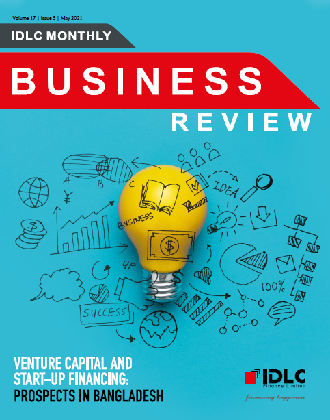
Venture Capital and Start-Up Financing: Prospects in Bangladesh
Investing in innovation: Venture Capital and Start-Up Financing in Bangladesh
Bangladesh is enriched with all the features to be recognized as a great macroeconomic story. However, we are yet to utilize our story compellingly. If we consider our regional peers, we will observe that they have carefully nurtured their startup ecosystem to the point that they are reaping the benefits now and writing success stories like Gojek, Tokopedia, Meesho, CRED, and so on.
In Bangladesh, banks can specifically finance a new business to the extent that there are collaterals against which the debt can be secured but in today’s information-based economy most of the startups do not have collateral. Thus, Venture Capital (VC) exists to the rescue. The main idea of VC is to invest in a startup’s growth until it reaches a sufficient size and credibility so that it can be sold to a corporation, or institutional public-equity markets can step in and provide liquidity.
Bangladesh’s startup ecosystem has shown great breakthrough over the past decade, companies such as Bkash, Chaldal, Pathao, Shohoj, and Bdjobs are some prominent names who ventured into this space earlier in the decade. Moreover, during the pandemic, the startups of Bangladesh have stepped with their technology-enabled solution, and have solved multivariate problems.
Currently, the ecosystem is seeing an increasing number of startup-ups but not enough funding available locally. Fundraising in Bangladesh has always been relatively tough for the aspiring founders in the early stages even with considerable traction and proof of concepts.
Appreciatively, this is where the ecosystem got attention from foreign investors and the acceleration took place in specific sectors such as ridesharing, e-commerce, delivery solutions, consumer services, and payments. However, the government of Bangladesh also initiated its own public startup support wing, Startup Bangladesh with a 100 crore BDT (U$ 11.5Mn) fund to catalyze investments. To supercharge the startup ecosystem, they have conducted multiple competitions and boot camps as well. Startup Bangladesh has been actively investing in the ecosystem with 100+ startups receiving seed funds over U$ 1.5Mn+ over the past few years.
Mutual cooperation among different stakeholders is the ultimate way forward for the further development of this ecosystem. Entrepreneurs need to come up with innovative solutions to solve real problems with large market addressable markets. On the other hand, local angel investors and institutional investors also need to understand deeply how does a startup operate in order to achieve its goal of winning the market but not profitability. Finally, working closely with the government is essential in order to unlock foreign venture funds.
Bonnishikha Chowdhury
Executive Officer
IDLC Finance Limited
Download View
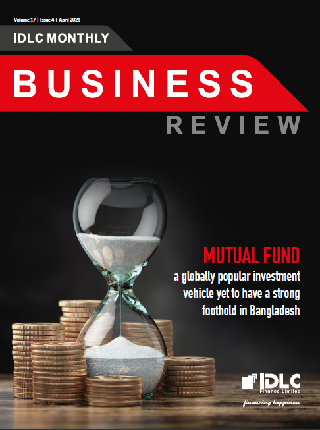
MUTUAL FUND: A GLOBALLY POPULAR INVESTMENT VEHICLE YET TO HAVE A STRONG FOOTHOLD IN BANGLADESH
Mutual Fund: Potential to be popular household financial instrument in Bangladesh
Mutual fund is most preferred by the investors worldwide not only because of its higher return yielding nature compared to other household assets but also because it assists the investors by offering professional fund management service with the benefit of diversification and lower investment cost. Even though mutual fund was first introduced in 1980s in Bangladesh, the industry growth has not been very noteworthy.
In developed countries, the size of the industry in terms of Asset under Management (AuM) has sometimes become even larger than the economy itself. The largest mutual fund industry in the world belongs to United States of America (USA). As of 2019, 12.9% of the household financial assets are invested in mutual funds in USA. Among Asian countries, Malaysia (54.0%), Japan (40.6%), and South Korea (34.6%) have been successful in building a sizeable mutual fund industry compared to their economy. The southern part of the region is still struggling. However, India (14.2%) in this regard showed tremendous progress compared to its regional peers like Pakistan (1.5%), Sri Lanka (1.3%) and Bangladesh (0.5%). If the factors behind the tremendous progress of India considered, it can be observed that initiatives such as government incentive, systematic investment plan, product variety, Presence of a structured and active association etc. played a vital role.
On the other hand, this industry of Bangladesh is yet to boom. Innovative and prudent strategies from asset managers along with policy support can take this industry to a new height.
Sushmita Saha
Assistant Manager
IDLC Finance Limited
Download View
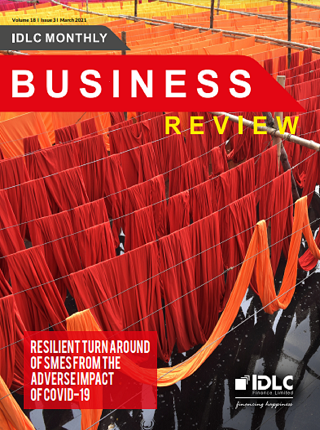
RESILIENT TURN AROUND OF SMES FROM THE ADVERSE IMPACT OF COVID-19
Recovery of the SME Sector: An Essential for Ensuring Economy’s Overall Survival
Like in most other nations, the outbreak of the COVID-19 pandemic was unprecedented and shook the Bangladeshi economy. One of Bangladesh’s most prominent industries, the fisheries and livestock industry, employing about 70% of the individuals in the rural areas was struck hard. The dairy farmers also lost around BDT 189 million daily during the lockdown. The disruption of activities in the transportation industry, broke down the supply chain of the construction industry as shipments were delayed. Traders could not operate for two months, causing the price of construction materials fell significantly. Similarly, the fixtures and furniture industry, which employs the second highest number of workers in the country after the RMG industry, lost 70% of its business due to the pandemic, causing 0.60 million worker to be laid off. The non-allopathic or alternative medicine industry on the other hand is one of the few industries to make profit from the pandemic as people turned to Ayurvedic products, Naturopathy and Yoga to boost their immunity. At the same time the demand for Homeopathy medicine saw a sharp rise as people visited Homeopathic practitioners to treat any symptom related to COVID-19.
On the other hand, disruption of activities in the food and food processing industry, resulted in decreased sales for super shops and local vendors, while online sales saw a huge surge. At the same time the price of important staples rose by 15-20%. The local textiles industry faced losses due to an increase in price of raw materials. The light engineering sector, like most other sector also suffered a huge loss as 90% of the workshops were forced to shut down. The situation improved for most business once the lockdown was lifted, with many business recording higher profits than the previous years. The government’s stimulus package worth BDT 5000 crore also fastened the recovery process.
Sushmita Saha
Assistant Manager
IDLC Finance Limited
Download View
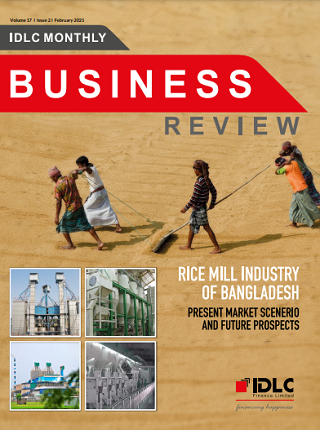
RICE MILL INDUSTRY OF BANGLADESH: PRESENT MARKET SCENERIO AND FUTURE PROSPECTS
The Rice Mill Industry of Bangladesh: Surviving throughout pandemic and bringing technological change
Corona virus has affected almost every spheres of life in the world including different businesses and industries where agricultural sector is not an exception. Rice is the most vital element of this agricultural sector. The average per capita rice consumption in Bangladesh stood at around 179.9 kg per year from 2016 to 2019, more than three times the world average. According to the USDA, approximately 500 million tons of rice were produced globally during 2019-2020. Bangladesh ranked fourth, contributing about 7% to the world production. Despite being one of the leading producers, Bangladesh cannot find a place among the top five rice exporters since its output is used to meet the domestic demand. Our domestic demand
has almost tripled since independence, causing us to somewhat dependent on imports to meet the demand.
Due to technological advancement and changing demands, the rice milling sector in Bangladesh has slowly shifted from the traditional “Dheki” or husking method of processing paddy to a more automated process. More than 12,000 husking mills had to shut down between 2012 and 2014 as they could not compete with the auto and semi-auto rice mills. Currently, 18700 public and private rice mills operate in Bangladesh, mostly in the North Bengal region. These mills broadly produce three categories of rice- Aus, Aman and Boro.
Since rice is a non-cyclical product, its demand is relatively inelastic. As such, the pandemic did not have much effect on the sector. Although the producers faced a temporary cash crisis during March and April due to the lockdown and limited banking hours, the situation improved from May and onwards. Handsome production and suitable government policies helped the producers to avoid any difficulty during the pandemic. Sales increased as people hoarded rice due to uncertainty, and different organizations procured rice for relief distribution. As a result, during the third quarter of 2020, the price of rice increased by BDT 5-7 per kg.
As technology advances, we need to use more modern technologies such as drones and field sensors in our farming process and adopt Climate Smart Agriculture (CSA) to boost our productivity. These need to be implemented almost immediately as we lose 1% of our cultivable land every year due to growing population demands. The government should also ensure proper financing and insurance facilities for the producers. Doing these will decrease our dependency on the RMG industry as our sole exporter and allow this industry to be a potential source of our export income.
Sushmita Saha
Assistant Manager
IDLC Finance Limited
Download View
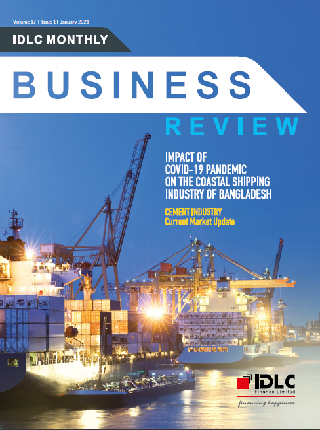
Impact of Covid-19 Pandemic on the Coastal Shipping Industry of Bangladesh
The Costal Shipping and Cement Industry of Bangladesh: Recovering from the Pandemic Wave
The cement industry of Bangladesh has beenrecognized as one of the fastest growing cement markets worldwide, with a double digit growth rate over the last decade, and an annual demand of around 33 million tonnes. This is owing to the construction of mega projects undertaken, and the constant infrastructural development on way to further develop the nation. Yet Bangladesh remains as one of the least cement consuming nations in the world
topped by China, India, Myanmar etc. The deadly wave of the Coronavirus, followed by lockdowns has had an adverse impact on an industry that employs over 10,60,000 people directly and indirectly. Disrupted supply chains, halted projects, and fluctuating exchange rates have made it challenging for cement manufacturers and exporters to maintain a smooth business flow as companies incurred losses and capacity remained underutilized. However, investors remain hopeful of the future as they approve fund to enhance the cement production capacity of Bangladesh.
As we speak of exports and imports, a crucial industry comes into focus – the Coastal Shipping industry of Bangladesh, which not only assists trade but plays a vital role in the inland waterway transport system. Lightering vessels,in particular, have played an important role in assuring safe offloading process from Mother Ships as ports in Bangladesh are not deep enough for many international ships to navigate through. Necessary lockdowns, to contain the virus, have forced trade levels down, allowing only drugs and other essential commodities to be traded. This put lightering vessel companies in a state of despair as they struggled to cover their overheads with minimal business activity. However, as lockdowns slowly recede and several mega projects start construction,the industry is showing promising growth prospects.
Sushmita Saha
Assistant Manager
IDLC Finance Limited
Download View
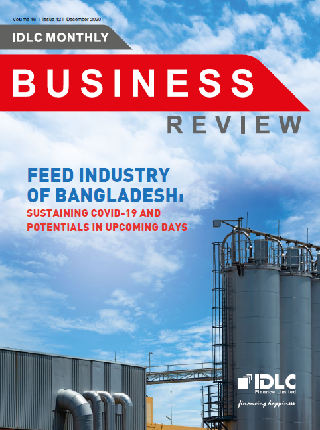
Feed Industry of Bangladesh: Sustaining Covid-19 and Potentials in Upcoming Days
Feed Industry of the country: Surviving the Outbreak of COVID-19
The agricultural industry of Bangladesh remains of pivotal importance, contributing 13.35% to the GDP of the country. Out of this, 4.95% is contributed by poultries and fisheries, which would not have been possible without proper nutrition provided by the feed mills. This establishes the far-reaching importance that feed mills hold in ensuring quality output from the agricultural sector. Globally, the feed industry generates about US $400 billion from compound annual feed production of 1 billion tonnes. Over 130 countries are involved in the production process or sale of feed which generates employment opportunities for many.
In an obvious attempt to contain the virus, governments all over the world, introduced lockdowns, limitations on travel and business opening hours. All of these has had an unnerving impact on the feed industry alongside many others. Lockdowns and logistical blockages have created movement restrictions, halting business activity. And no just that, even rumors concerning the spread of coronavirus through poultry and other meat consumption has had a significant impact on the industry’s turnover. Supply chain disruptions leading to a loss in dairy and meat products have affected the feed market as well. Disruptions in the supply chain created wastage despite high demand in the markets, and trade halts have stopped raw materials from coming into the country which had severely impacted the feed mills industry and its stakeholders.
However, lockdowns have given a lot of people time to reflect on many decisions and directed them towards taking healthier steps, for instance. The increased consumption of meat, alongside growing awareness about livestock nutrition has led to an expansion of the market size of feed and feed additives globally. In Bangladesh, commercial feed production experienced a near 25% growth over the last decade. A number of feed mills were established to meet the upsurge in feed demand and the local market expanded subsequently, with poultry feed holding the most market share, followed by fish feed and then cattle feed.
With the world slowly stabilizing after the impact of the pandemic, the only hope is to look ahead into the future towards a prosperous local and global feed industry, and a safer and healthier world.
Sushmita Saha
Assistant Manager
IDLC Finance Ltd.
Download View
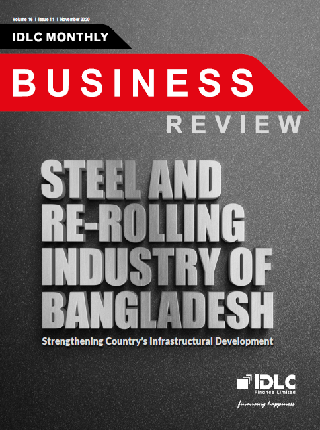
STEEL & RE-ROLLING INDUSTRY OF BANGLADESH: STRENGTHENING COUNTRY’S INFRASTRUCTURAL DEVELOPMENT
Steel and Re-Rolling industry: fast paced recovery from pandemic on the cards
The Steel and Re-rolling industry, one of the prominent growth drivers of Bangladesh, has had its fair share of hit by the Covid-19 pandemic. This has been reflected on numbers as world crude steel production recorded a 3.2% decline compared to figures recorded in the same time period last year. As a developing nation with increased focus on to infrastructural development and lined up mega projects, Bangladesh sees massive growth potential in the Steel industry. With a market size of around BDT 450 billion the local Steel market employs nearly 1 (one) million people directly or indirectly across the country. The market has been growing at a rate of 15%- 20% for the past 2 years and contributes largely to the country’s GDP. However, the market for steel is turning into a perfectly competitive one from an oligopolistic structure as small players are now gaining efficiency and reaching competitive levels of their larger peers such as AKS, BSRM, KSRM etc. With the growth of the smaller companies, it is safe to say that the challenges that come with surviving in the Steel industry – such as, abundant supply of power and gas, availability of raw materials etc. are being well taken care of.
The Steel industry strategically runs on overcapacity. It is seen that the utilization is around 75% of total capacity which came down to 40% due to the pandemic wave. The prices of raw materials and finished goods are also seen to fall. However, as a resilient nation, Bangladesh is adapting fast to the new challenges that came with the pandemic. And, as we look towards a new normal, companies in the Steel industry must work in collaboration with regulators in order to sustain the growth and maintain the level of efficiency reached prior to the pandemic.
Sushmita Saha
Assistant Manager
IDLC Finance Limited
Download View
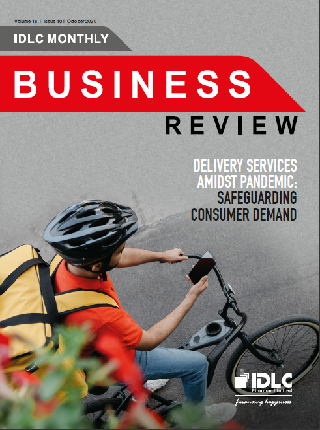
DELIVERY SERVICES AMIDST PANDEMIC : SAFEGUARDING CONSUMER DEMAND
Delivery Service to the rescue for consumer demand in a pandemic-driven world
A global event as prominent as the COVID-19 outbreak is likely to have an impact on the life style of people all over the world. Thus, a sudden change in consumer behavior is not surprising, rather rational. However, the success of a business depends on how fast and efficiently it can cope up with any unfavorable situation as risk is a fundamental element of any business. Before pandemic, the biggest vertical to deliver for logistic service providers of the country was e-commerce and f-commerce, covering around 60% of the whole pie which mostly consisted luxury products. After the corona virus outbreak, in no time the demand for grocery and essentials reached sky-rocket. The market leader, Chaldal was receiving 16,000 orders per day which was only 2,500 before pandemic. On the other hand, food delivery services dropped by 80% since all the restaurants were closed. However, when the whole country was staying inside home in order to minimize Covid-19 contamination, the logistics service providers were serving day and night to cater the sudden shift of the consumer demand. They responded to the situation swiftly by either extending their verticals or shifting their concentration to adjust the shift in market dynamics. As we are moving on with this new normal arrangements, the booming sectors must capitalize on this opening at once and focus on practices like consumer retention, that will make this growth more sustainable. On the other hand, a post COVID-19 boom for the verticals which are lagging behind, seems to be on the cards.
Sushmita Saha
Assistant Manager
IDLC Finance Limited
Download View
MICROFINANCE SECTOR OF BANGLADESH : IMPACT OF COVID-19 PANDEMIC AND POST PANDEMIC PROSPECTS
Assistant Manager
IDLC Finance Limited
Download View
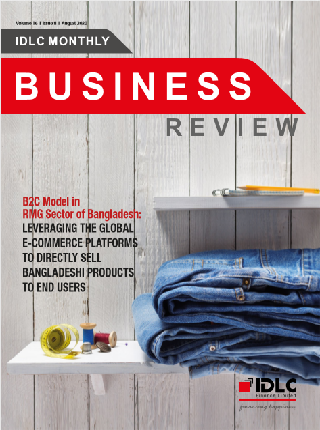
B2C MODEL IN RMG SECTOR OF BANGLADESH: LEVERAGING THE GLOBAL E-COMMERCE PLATFORMS TO DIRECTLY SELL BANGLADESHI PRODUCTS TO END USERS
From “Made in Bangladesh” to “Brand of Bangladesh”: Global E-commerce Platform may Open up New Horizon of Opportunities for Local RMG Manufacturers
It has been 40 years since we are serving the global big brands with our products and designs with pride. However, we are still stuck in the back of the labels or tags and it is high time to level up our game and reach the consumers as a brand. The traditional B2B model may be convenient in many ways but after the Covid-19 break out, it showed us how largely it made us buyer centric. When buyers default, it directly hits our largest export earning sector which is apparently the earning source of 4.5 million people of the country. As of April 2020, global brands and retailers, who purchase clothing goods from Bangladesh, have cancelled & suspended work orders worth $3.18 billion, which directly affected around 2.28 million workers and the dependents of their income. In this circumstances, B2C can be the perfect contingency plan for us to come out of the shadow of the buyers and establish our own market.
With an already established good name in the global apparel industry and growing e-acceptability of e-commerce, it is rather easy for us to penetrate the global consumer market. Moreover, with the hope of relocation of Chinese RMG sector in Bangladesh, the opportunities are even getting bigger. However, there are roadblocks to overcome too. Most of our manufacturers are not aligned with the B2C e-commerce yet and our policies are not yet B2C e-commerce friendly. On the other hand, our product range is not diversified enough to cater the need of consumers around the world as a retailer. However, with the strong willingness of the local manufacturers and policy support we can definitely expand our horizon across the borders.
Sushmita Saha
Assistant Manager
IDLC Finance Limited
Download View

MFS sector of Bangladesh safeguarding currency mobility during pandemic
The flying MFS Sector of Bangladesh
Growth can only be sustainable when the whole population is benefitted from that.
The value addition of Mobile Financial Services (MFS) in a pandemic-hit vibrant economy like Bangladesh has been remarkable. Till March 2020, the scope of MFS was only confined in cash-in, cash-out, bill and other payments, remittance and some other ancillary services. However, the great pandemic broadened the horizon of MFS service, starting from disbursing wage to 4,000 RMG workers to disbursing government cash support to 50 Lac families. MFS is discerned to be the game-changer in payment landscape, with players like Nagad, bKash, Rocket and Surecash.
Banks are seeing immense possibilities of mobile money for financial inclusion. In a time when cash transactions pose near life-threatening risk due to containment of deadly virus, mobile money is acting like a life-savior. Not all banks have a strong infrastructure to facilitate MFS. Aside from balance transfer, banks now must work on managing payment mechanism on mass scale, for loan or deposit products. It is high time, banks should collaborate with MFS providers and reap the most benefit out of their payment infrastructure. Rocket by Dutch Bangla Bank Limited, uCash by United Commercial Bank Limited and many more have jumped on the MFS bandwagon sensing the breakneck growth opportunity. In the “new-normal” era, digital payments will take the lead and reaching mass population is only possible with the help of MFS.
Sushmita Saha
Assistant Manager
IDLC Finance Limited
Download View
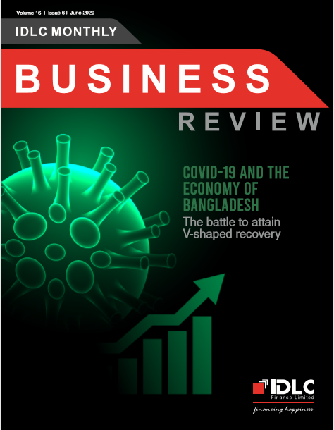
COVID-19 AND THE ECONOMY OF BANGLADESH: THE BATTLE TO ATTAIN V-SHAPED RECOVERY
COVID-19: The pandemic to lead and work through together
“This is like a world war, except in this case, we’re all on the same side.”
Quoting the tech tycoon Bill Gates about the extent of damage the virus is creating to health, wealth and well-being.
From the beginning of this crisis, every country is effectively working to minimize the virus spread, limiting travel, imposing lockdown for months, testing and treating patients and cancelling social gathering even in the festivals. Then again, predicting the impact of this deadly virus is not an easy task for a developing country like Bangladesh, a densely populated country with a not-so-developed healthcare system.
From economy front, the country is having a hard time due to prolonged lock down and disrupted supply chain situation for most of the industries, apart from a handful industries for instance, grocery, and pharmaceuticals. Construction sector is facing the heat as the progression of mega projects slowed down. Banking sector is in a tight spot due to halting of private sector credit disbursement, reduction in settlement/opening of new LC and borrowers’ inability to pay EMI. However, digital payment solution might be the one good thing came out of this pandemic, where starting from social safety net disbursement to RMG workers’ wage disbursement – all happened in Mobile Financial Service (MFS) platform. As tough this situation as is for the business communities, stimulus packages declared by the government is likely to come to a relief.
The year 2020 is deemed to be game-changer in wake of this pandemic. The way of our approach to health, business, commute and every small details will be reshaped, like after every pandemic in the past. The post-pandemic world will need a lot of collaboration from our countrymen to start from the start.
Sushmita Saha
Assistant Manager
IDLC Finance Limited
Download View
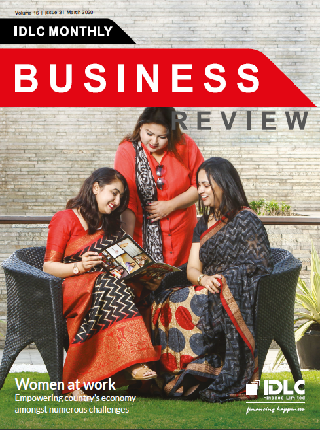
Women at work : Empowering country’s economy amongst numerous challenges
Each for Equal: A journey towards ultimate attainment
There was a time when women in leadership positions were thought to be an impossible dream. Things have evidently changed as now we can see women like Indra Nooyi, former CEO of PepsiCo, has consistently ranked among the world’s 100 most powerful women. In this competitive world, when we look around, there are a number of inspirational women come to our mind who are leaving their footprints in different areas of expertise and endeavor.
The theme for this year’s International Women’s Day is #EachforEqual which promotes the concept that an equal world is an enabled world. Bangladesh has achieved tremendous success by narrowing down the gender inequality in workplaces and has earned good reputation in every sector for creating scopes for its women to participate in the workforce. Businesses are being reshaped and revamped due to women’s involvement in F-commerce. According to the World Economic Forum index,
Bangladesh is leading the entire Asian region in terms of female workforce participation. 18% of board seats in Bangladesh are held by female directors, which is higher than other countries in the South Asia region. Bangladesh also tops its neighbors in the latest World Economic Forum’s Global Gender Gap Index, ranking 50th among 153 countries. However, a recent IFC study showed that in Bangladesh, only 5% of all independent directors of 294 companies listed on the DSE, are women.
Among various reasons, the progenitive role of women constrains them to choose between motherhood and their career. Multiple obstacles remain unchanged for women both in law and in culture. Still now, in the developed parts of the world, women are undervalued. That is why, female employees’ career becomes stagnant in the mid-level. The principles of valuing female in the workplace is indispensable in order to bring out their inner potential. Many research and survey conducted internationally suggests that opportunities should be made available so that the female employees do not feel discriminated and get the opportunity to perform symmetrically alongside male employees. Every working sector should realize the impact of the role of women and work on it so that from academics to corporates, medical to business, more women can shine bright.
Sushmita Saha
Assistant Manager
IDLC Finance Limited
Download View
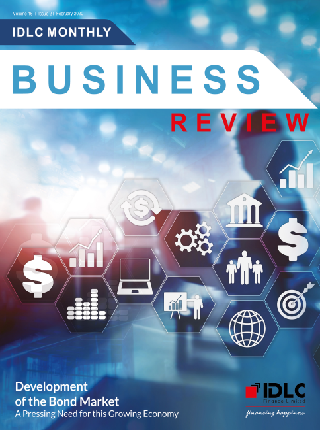
Development of the Bond Market – A Pressing Need for this Growing Economy
“Bangladesh booms in a sluggish world economy, while economies slow for its South Asian neighbors; Bangladesh is hitting record growth rates”, is the statement of *The Diplomat on the accelerating growth of our economy. However, the wheel of growth will be continuously running only if it is fueled by continuous funding.
The financial sector of Bangladesh is mostly bank dependent but the appetite for fund is not always same under all the circumstances. In order to maintain stability in the economy, it is important to ensure the presence of both long and short term sources of funds. The global infrastructure outlook estimates that, currently we have an investment gap of $192 billion*. Considering the running mega projects and upcoming long term projects, long term nature of bonds investments with flexible structuring mechanisms & repayment structures might be the best fit to cater the capital expansions. Moreover, it is never a good idea to be largely dependent on banks since there are always risks of liquidity and mismatch. However, if countries with stable economies are considered, it can be seen that corporate bonds act as one of the most stable source of financing for the public sector, for example corporate bond market to GDP ratio is 150% in USA, 60% in China and 60% in Malaysia*. On the other hand, our government bonds outstanding would be worth about $17.2 Billion whereas corporate bonds outstanding is only $0.3 Billion*. Unfavorable policy support can be attributed for such lack of interest in this sector but absence of secondary market also plays a vital role too. A well-established bond market is not only beneficial for issuers and investors but also spreads investment risks across investors and intermediaries. Therefore, for a rapidly growing economy like ours, investment growth can play a crucial role.
* https://thediplomat.com
* https://outlook.gihub.org/countries/Bangladesh
* https://www.thedailystar.net
* https://www.adb.org/publications/asia-bond-monitor-november-2019
Download View
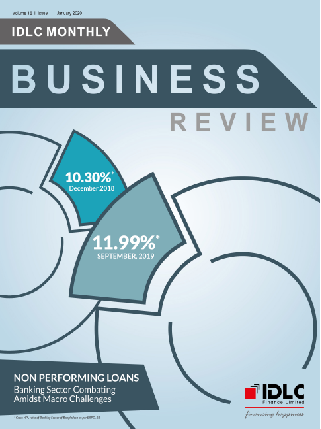
Monthly Business Review - January 2020
Bangladesh, the once “bottomless basket” has grown to be the new “Asian Tiger”, on account of incessant growth in the last decade. International investors are eyeing for Bangladesh as a promising investment destination due to immense growth opportunities. Also, the ongoing mega projects will change the blueprint of the country’s infrastructure, which is considered to be an obstacle in doing business.
However, the ever-piling up non-performing loans in the banking sector can make the situation worse.
Non-performing loans eats up the portion of loanable fund of a Financial Institutions by keeping provision, which was otherwise supposed to be channeled to the deficit sector i.e. the business entities or to productive sectors. As of November 2019, government already borrowed 90% of its annual limit from the banks, which will in turn, reduce banks’ portion of loanable fund. Further NPL pressure may aggravate the situation and lead to a liquidity crisis. Alongside, rising non-performing loans will have a direct hit on banks’ solvency scenario, for which banks may succumb to an unhealthy position in long run.
As NPL is constantly becoming a burning issue for the banking sector as well the economy, NPL management is need of this hour. Reinforcing good corporate governance is a prime activity for the sector. Instances of how companies become bankrupt in absence of good governance are aplenty worldwide. In India, merger between the strong banks and the weak banks (in terms of balance sheets) is evident recently as the problem of non-performing bank loans has emerged over the past few years. Our banking industry can also follow their suit, as combining portfolios can provide additional risk diversification. Lastly, establishing Asset Management Companies (AMC) which will purchase the toxic assets of the banks at a discount, and collect from the non-performing assets via selling securities over the years. Without taking care of ever-stacking NPL, the banking sector cannot contribute to the real economic growth. Hence, it is high time the top management of the FIs should come up with effective solutions.
Download View
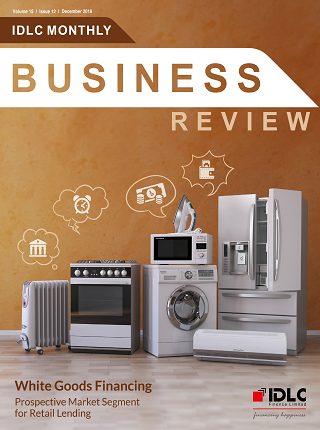
Monthly Business Review - December 2019
According to a study in 2015 by the Boston Consulting Group, the middle and affluent class (MAC), which includes households that earn at least USD 401 (or BDT 34,000) per month or higher, in Bangladesh is expected to grow to 34 million in number by 2025. Which means, in the coming years the demand of the consumer durables will increase significantly.
Question may arise out of all the consumer electronic durables, why only financing of white goods (large machines with an enamel finish; for example: refrigerators, air conditioners, washing machines, microwave ovens etc.) is more focused here. The answer is simple, it’s growing demand. Even a few years ago air conditioners or microwave ovens used to be a sign of luxury but now a days such products can easily be categorized as necessity. One of the reasons behind such rapid growth in usage can be increased purchasing power but the role of nuclear families or working women cannot be denied. Convenience is the biggest selling trait of any product in the modern world.
Although the middle income class has drastically risen in the last decade, people are not comfortable spending large amounts of money at once. India has achieved a praiseworthy expertise in case of white goods financing. 60% of the total sale are now made through specific financing instruments out of which only 12-15% is via credit card. With the blessings of data analytics and alternative credit scoring, India is now capable of analyzing a client’s credit worthiness within few minutes which helps them to cater the growing need efficiently and this is where we have a great scope for improvement. However, to achieve such expertise, the first and foremost requirement is infrastructural development and expertise on data analytics. Moreover, regulatory incentives are also necessary to reach such accomplishment.
Download View
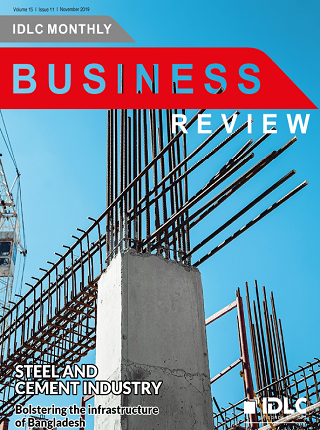
Monthly Business Review - November 2019
In 2018 alone, total consumption of steel in Bangladesh was 7.5 million metric tons, recording 37.5% growth y-o-y. Per capita steel consumption almost doubled in five years, amounted to 45 kg in 2017. Steel production capacity soared to BDT 30 lakh tonnes in FY 15-16, from BDT 10 lakh tonnes in the preceding fiscal. Thanks to these mega infrastructural projects, Bangladesh is now self-sufficient in billet production, when even five years ago, the country had to import half of the total billet requirement to feed the domestic market. On the other hand, the sale of cement, another prime construction material, registered 12% growth in 2018 y-o-y. Cement consumption in Bangladesh is mostly rooted in individual homemaking (40%), followed by mega projects (35%) and real estate sector (25%). The cement industry, however faces far more significant challenges in the import area, with countries (especially Vietnam) racking up the price of raw materials such as clinker. The market price of cement rose in the past 2 years, this coupled with the fact that there are 32 cement manufacturers in the country and the existence of intense competition among them, makes pricing a significant challenge.
Download View
Monthly Business Review- October 2019
Private commercial banks in Bangladesh have been historically shying away from micro lending. Since 2009, banks’ share of microcredit lending never crossed the threshold of 15%. Few phenomena led to this behavior:
· On scalability front, the loan size of micro loans are so meagre compared to the average ticket size of private commercial banks. Therefore, in order to be make micro lending scalable enough, banks have to finance a substantial number of micro enterprise.
· On operational efficiency front, in order to reach the desired volume of micro enterprises and provided that microcredit assessment is extremely laborious due to lack of data, banks will have to deploy a greater number of human resource and thus incur higher operational cost. At the same time, the operational cost required to underwrite a micro loan is almost same as that of a large loan.
Having said that, a handful of private commercial banks started venturing into micro lending in recent times. Digital adoption in the operational process of micro lending is a way banks can achieve scale in micro lending. BRAC and few other MFIs introduced Digital Field Application (DFA) where the field officers can directly input client data in tab, instead of manually writing down on the sales sheet and then again input in their software. It is high time, banks should penetrate into this market by being digitally innovative. At the same time, regulators should address easing of requirements like KYC, excise duty, trade license and TIN to encourage banks penetrate into this market by making the assessment process cost-effective.
Download View
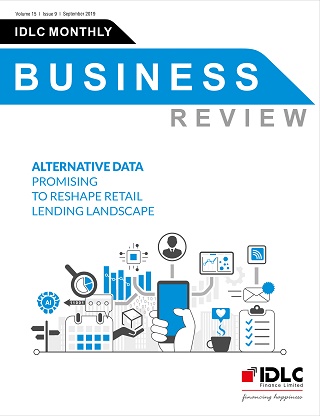
Monthly Business Review- September 2019
In global retail lending realm, alternative data is capturing the spotlight as it creates the opportunity to finance the unbanked and underbanked portion, as well as making the risk model more accurate with more data. Alternative data, or more even correctly “credit-adjacent” data includes lots of data that are not being used in conventional credit underwriting process, for instance, utility usage, locational movement, mobile data usage, employment track record, involvement in digital platform and the list continues.
From a global picture, fintechs started the use of these data in the process of credit evaluation to reach those customers who are out of banks’ periphery. Having discerned fintech’s growing portfolio and faster loan processing, legacy banks are coming out of their conventional shell, some collaborated with fintechs. In Bangladesh, usage of alternative data in lending is still not evident, except for taking performance of utility bill payment and rent payment in some cases. Availability of refined data is a challenge in our market. Banks have the largest customer data repository, but can hardly use them because they are scattered and unstructured. Another fact is, currently we do not have one single touch point where a customers’ all basic information, purchase history (online/offline), credit history, asset details are available (like Aadhar card, Permanent Account Number- PAN card in India). Ant Financial of China has created a financial services ecosystem by zeroing in on alternative data and bringing more consumers into the periphery. Having said that, our local startup ShopUp set a good example of lending with a credit scoring model using alternative data. It is high time that Financial Institutions should understand the importance of building their risk model using alternative data if they want to reach scalability and accelerate operational efficiency.
Download View
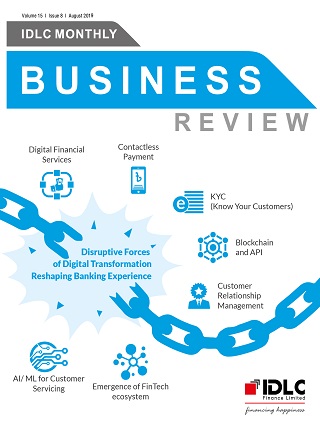
Monthly Business Review- August 2019
In pursuit of “Digital Moment”
The global banking sector faced a new wave of change when the news of AntFinancial, Tencent and Xiaomi Corp. won virtual banking license in Hong Kong. Mobile cash is catching on in the world’s less advaced economies, in some cases, leapfrogging traditional banking. M-Pesa (Kenya) and Telenor Microfinance Bank (Pakistan) have set example of how unbanked citizens increasingly use phones to connect to the digital economy.
Modern digital technology has disrupted this legacy banking model on all levels, starting from enhancing customer experience to bring agility in the credit operation to streamlining back-office related activities, by simply leveraging on customer data. In a world where “data is king”, the cutting-edge technological inventions transformed the aura of banking services in the past two-three years. In India, ICICI Bank, HDFC Bank, Axis Bank and SBI are now deploying big data to customer profiling, collaborating with e-wallets to make the payment system more convenient, putting analytics into play in creating loan scorecards and gradually partnering with fintechs to leverage their technology for superior customer experience.
Bangladesh, albeit trailing far behind from neighboring India when innovation in banking service is in question, however, started making strides. The top banks of Bangladesh are showing an interesting trend in the commitment of organizational leadership for offering digital banking services. Few initiatives by local banks for instance, coming up with paperless e-loan for individual purpose, implementing blockchain technology (pilot basis) for trade finance, partnering with e-wallet (iPay and bKash) and so forth. Although regulatory challenge, for instance, eKYC is still there, the good news is it is being addressed from policy level. It is time regulators should undertake more “digital-friendly” initiatives so that local banks start putting data and technology into play to provide one-stop, paperless and on-the-go banking solution to its customers.
Download View
Monthly Business Review- June 2019
More sustainable CSR initiatives in the offing
Corporate Social Responsibility (CSR) and sustainability have been at the forefront of most companies’ agendas for quite some time- it is no longer a “nice to have” but a “need to have.” The fact that millennial have a high level of social awareness and they are entering into the formal job market, gives most corporations solid reason to be “purpose-driven”. Giant corporations like Google, Microsoft are deemed as the world’s most reputable companies for CSR activities. Having said that, Financial Institutions are coming in the front row in the realm of CSR and sustainability.
In Bangladesh, the banking sector is embracing a bunch of initiatives to address social/environmental issues. IDLC CSR Guideline confers to International Standards and has maintained signatory membership status with both United Nations Global Compact (UNGC) and United Nations Environment Programme Finance Initiative (UNEPFI) since 2011. In the past few years, commercial banks of Bangladesh have witnessed a splendid CSR expenditure in areas of education, health and disaster management. The CSR outlay took a leap in 2018 to BDT 904.7 crore from BDT 743.9 crore in 2017, triggering 21% y-o-y growth. In order to raise the banking sector’s spirit to be engaged in sustainable CSR initiatives, Bangladesh Bank determined some areas of tax exemption related to CSR for Financial Institutions. When that is a good start to make the financial sector more people and community-oriented, it has to be kept in mind that whether these initiatives are bringing infrastructural development for the long term benefit rather than being just a one-off initiative.
Download View
Monthly Business Review- May 2019
During July-February of FY 2018-19, the net sale of National Savings Certificate (NSC) exceeded the target for the entire fiscal by 35%, already BDT 5,602.49 crore worth of NSCs sold against the target of BDT 26,197 crore. Deposit mobilization for the same period registered only 9.6% average growth. On the other hand, according to media reports, USD sale by Central Bank increased to a greater extent, to the tune of USD 1.87 billion in July to March of FY2018-19, whereas BDT 84 for USD 1 sale is being withdrawn from banking system.
Central Bank already took measures to address the liquidity situation, for instance, reducing the Cash Reserve Ratio (CRR) to 5.5%. However, sale of NSCs can only be ensured to those in need of social safety net. Also, it is high time Government should focus on money market (banking system) and capital market (bond) as alternative source of funding.
Download View
Monthly Business Review- April 2019
Banks/FIs deserve accolades for expanding their SME portfolio over the past years and thus exceeding the SME disbursement target given by the Central Bank. However, the financial industry is still saddled with some concerns when SME lending is in question. Banks find it hard to consider SME loans as a core focus segment because of the higher cost of monitoring and underwriting, as SMEs are scattered all across the country and are unstructured in terms of account management. Therefore, underwriting of SMEs is expensive and time-consuming since the cost and underwriting process for all borrowers (irrespective of size and value) are similar. FIs can come up with scoring models for SME businesses by deploying technology leveraging on the huge set of customer data. Also, more than just funding, small businesses require business management tools and advice on how to
diligently manage working capital and FIs are the best fit to help them out in this scenario.
Lastly, this is worthy to mention that the whole financial industry played a crucial role in building SME ecosystem and educating the market at this level, with prudent guidance from the Central Bank. Now, expanding the SME market reach in a low cost manner, by deploying technology should be the priority of Banks or FIs.
Download View
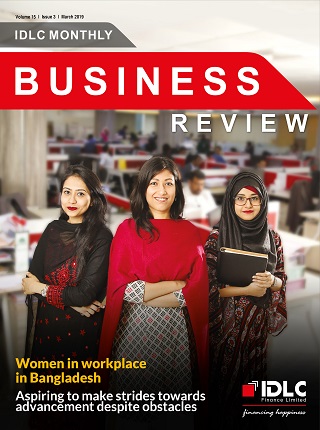
Monthly Business Review- March 2019
In the realm of global corporate leadership, one name resonates loudly across industries and regions: Indra Nooyi, the former CEO of PepsiCo. Hailing from the diversified India, Indra changed the face of PepsiCo when the brand was witnessing dwindling popularity. After she stepped down as the CEO after 24 glaring years in PepsiCo., market analysts are terming the position “very hard to replace” in wake of Indra’s bold and thoughtful leadership style.
This year, the theme for International Women’s Day is aptly kept- #BalanceforBetter. In Bangladesh, Ready Made Garments (RMG) has been the frontrunner in empowering females, where 4 million women found their earning source. Over the years, SME sector has also witnessed surge in active women entrepreneurs, who are highly motivated and aspired to take their business to a whole new level. The growing participation of young female entrepreneurs in F-commerce realm also deserves accolades. In corporate level, however, an unbalanced trend is discerned as we move up along with the hierarchy ladder. Female employees start falling out as they move to the mid-level in career and start having their own family responsibilities, resulting in a vacuum in top leadership positions. In many research and survey conducted internationally, it has been reflected that women make difference in the boardroom and in the company culture when they are put at helm of a company. It is high time, local corporates should recognize the fact and start working on the female potentials to the betterment of the company and coming up with suitable initiatives and facilities for them. Perhaps, down the line, Bangladesh may give birth to a number of Indra Nooyi’s who will change the face of the total economic scenario with their prudent leadership skills.
Download View
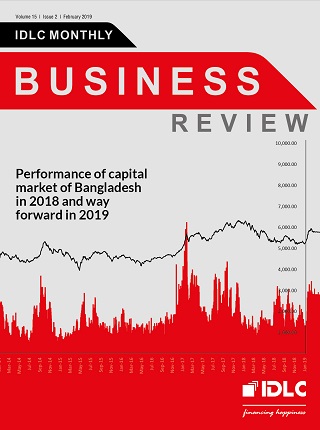
Monthly Business Review- February 2019
Bright picture for Capital Market in 2019
The Market Capitalization (Mcap) /GDP ratio lowered to 17% in 2018 from 24% in 2014, whereas the peer countries mostly picked up for peer countries. One potential reason for this phenomenon is lack of listing of large corporates in the market. However, 2018 witnessed a number of developments in the form of partnerships and regulations. The strategic partnership between DSE and a Chinese consortium of Shanghai and Shenzhen Stock exchanges is expected to contribute in capital market improvement. BSEC approved the draft Qualified Investor Offer by Small Capital Companies Rules, 2018 that is expected to increase efficiency of the market by providing a separate market for small cap companies.
Future prospect of the capital market in 2019 looks bright as government expects GDP growth to be at 7.8% and inflation at 5.6%. Economic Intelligence Unit (EIU) and UN predicted Bangladesh to be one of the fastest growing economy. Provided that interest rates remain under control and liquidity conditions improve, the market is expected to perform better. Stable political environment will attract foreign investment and improvement of exports and remittance can help ease pressure on currency.
Download View
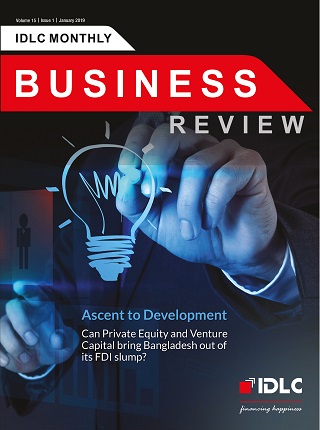
Monthly Business Review- January 2019
Bangladesh is now a role model in economic development boosted by its population and growing industrial base led by RMG industry. Economy is growing at more than 7% and projected to grow even faster in the future to become the 26h largest economy in the world by 2030. However, behind this rise lies multiple challenges revolving around infrastructural development and inadequate funds. Bangladesh needs to receive enough funding to sustain this growth and one industry has potential to do just that – Private Equity and Venture Capital (PEVC). Globally, PEVC backed companies are proven to generate more revenue and employment growth than non-PEVC backed companies.
However, for Bangladesh it’s still a distant reality. While the large start-ups of Bangladesh such as bKash and Pathao are gaining FDI and global attention, small start-ups are also on the rise guided by incubators and accelators. Thus, Venture Capital’s popularity is amassing but Private Equity still begs attention. Private Equity is shunned due to prominent obstacle such as, no local institutional investors, an economy reliant on debt financing, an obstinate corporate culture and huge tax rates on fund manager fees. Therefore, regulations and policies require structure and changes to promote local fund manager participation and attract international firms. Thus, a thriving PEVC industry is the catalyst for economy’s development that will unfold Bangladesh’s success through its manufacturing and tech sectors.
Download View
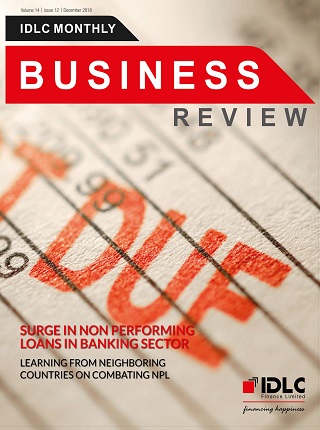
Monthly Business Review- December 2018
“The asset quality is deteriorating in the highly fragment banking system.”- the remark came on the recently published Moody’s outlook for Bangladesh banking system. Despite being a robust economy, Bangladesh is witnessing ever-growing trend in bad loans. The chronic deterioration in asset quality is ultimately hitting the banks’ profitability due to covering up for high credit cost.
For the nature of banking sector whose core job is to dealing with mass people’s money, bad loans are nothing new or unique. However, the pace it is growing is alarming. Aggressive endeavors by banks for portfolio target in this populated banking sector played substantial role for rise in NPL. Some other factors like lengthy judiciary process, uncertain business environment and no evidence of exemplary measures against habitual defaulters fuel the growth of piling bad loans. Countries like China, who drastically curbed their bad loan rate over the years, used social shaming as a technique to combat their bad rates. Then again, Malaysian government introduced separate Asset-Management companies to recover the non-cash collaterals by converting them to cash. In Bangladesh, in order to curb the bad rate, whereas due diligence on bank managements’ part is required, the judiciary process needs to be streamlined as well. Also, it is high time the banking sector altogether should take strict social measures against the habitual defaulters in order to combat their default culture.
Download View
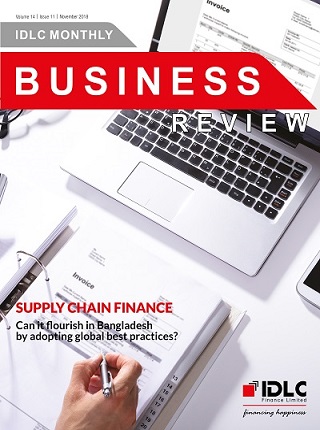
Monthly Business Review- November 2018
Although being a 20-years old market in Bangladesh financial sector, Suppply Chain Finance is yet to produce desired yield ascribing to some reasons. Firstly, there is a lack of understanding about the concept of supply chain finance and its products despite its immense potential in Bangladesh market. Corporate entities show indifference in backing up their suppliers, which is why suppliers have to take the fund at high rate. Also, here in case of non-payment of corporates, the supplier becomes delinquent to the banks, which is an unusual scenario in otherwise traditional loan products.
Reverse factoring, which is broadly applied in other parts of the world, has yet to get broader acceptability in Bangladesh market. However, the most crucial challenge is, supply chain finance is yet to be recognized as “a separate product” at regulatory level. It is still treated under the policy of Short Term Revolving Loan. However, some commendable initiatives such as Digital Supply Chain Finance Platform is taking place in the local market that breaths fresh air in this innovative product category. Also, there is a talk in the industry about the policy-making in regulatory level which will be the big push for this mode of financing.
Download View

Monthly Business Review- October 2018
Across the world, disruptive technologies from companies termed fintech, are providing financial services in a more tech-savvy way and in lightning speed, making potential customers slowly drifting away from the traditional services offered by banks. Having said that, banks have started realizing the power of Big Data, Data Analytics, Artificial Intelligence and lastly Blockchain. Big banks in India are now deploying big data to customer profiling, collaborating with e-wallets to make the payment system more convenient, putting analytics into play in creating loan scorecards and gradually partnering with fintechs to leverage their technology for superior customer experience. Bangladesh, albeit trailing far behind from India when innovation in banking service is in question, it started making strides. Top-tier banks coming up with smart downloadable mobile apps, emergence of the first-ever blockchain-backed universal payment platform namely uPay, the first e-wallet namely iPay are all testimonials that Bangladesh’s financial sector is on the cusp of technological disruption. Having said that, wealth of unstructured data, information availability and dearth of tech experts pose big challenge in this realm. Its time banks should realize the importance of data and start putting technologies into play.
Download View
Monthly Business Review- September 2018
Bangladesh is struggling with some stark realities in housing sector. Currently, 7 out of 10 households in Bangladesh dwell in conditions that are not permanent. In Dhaka alone, there are over 4,000 informal settlements, or slums, home to 3.5 million people, who consist of a majority of the workforce. Housing loan makes up only 9.1% of the total loan, which implies a big chunk of the population is totally off the radar of existing housing finance sector. Affordable housing comes to rescue in a bid to revive the fortunes of the flagging housing sector.
The idea of affordable housing is embedded in providing housing for the low and middle income (monthly income within the upper ceiling of BDT 60,000 or USD 750 as per IFC) households, a currently untapped segment in our housing finance sector. Most of the apartments constructed size more than 1000 sq.ft., for which, private developers eye to the upper-middle and upper classes for reputedly having high credit worthiness. However, the ever-burgeoning middle and affluent class, rising income of this segment, more nuclearization of urban families are prone to make affordable housing a compelling story for Bangladesh, the way it happened in India. Housing for low and middle income households grew triple in just 3 years in India, accounting for 21% of the total housing finance sector and anticipated to grow 30%-40% by 2025. For Bangladesh, it is a first-hand concept which is yet to be explored and has the power to be game-changer for housing sector.
Download View
Monthly Business Review- August 2018
Over the past decade, global e-commerce has been expanding at an average rate of 20% a year as bricks-and-mortar shops have languished. Although its share of total retail trade last year, at 8.5% worldwide, was still modest. Even in South Korea, the country with the highest percentage of retail sales online, online purchase accounts to 18% of total retail sales. The same statistics is 5%-6% for India and a meagre 0.7% for Bangladesh. However, there is every reason to think the pie will get bigger in upcoming decades, at least for Bangladesh.
In Bangladesh, rapid internet penetration, spread of cheap feature phones/smartphones and a vibrant youth pool brought more shoppers into this fairy nascent e-commerce ecosystem. Also, the thriving mobile financial service across all the parts of the country is reinforcing the e-commerce space of Bangladesh as the most preferred payment method. Having realized the untapped opportunities in this market, the Chinese smartphone maker Xiaomi already announced to open an ecommerce plant in Bangladesh.
Download View
Monthly Business Review- July 2018
Like every year, this year’s budget also has it’s share of encouraging and somewhat constraint policy changes for individuals, industries and economy as a whole. Several incentives are discerned in the budget to safeguard and boost local industries. Rice millers welcomed the reinstating of 28% duty on rice import. The increase in corporate tax for the RMG sector may erode the competitiveness of the largest export item of Bangladesh, since the cost of production is prone to increase. However, the recent decision of Government to cut down tax-at source to 0.7% from existing 1%, will bring the RMG makers some relief. Cut in the supplementary duty for hybrid cars (1600-1800 cc) in a bid to promote fuel efficient and environment friendly automotive industry, is also an appreciated green move. The slash in corporate tax by 2.5% for listed banks will definitely have a positive impact on the bottom line of bank’s profitability. Lastly, the 5% VAT imposed on the app-based ride-sharing services, which is a much necessary transportation mode now-a-days, may have a trickle-down effect on the consumers to some extent.
Download View
Monthly Business Review- June 2018
Ride-sharing has become a popular and quintessential phenomenon in most of the city-dwellers everyday life. The impact of bike ride-share is evident in 50% hike in bike sale in 2017. The immense acceptance of ride-sharing mainly ascribes to its door-to-door pick up and drop off service, ease of finding a vehicle in emergency hours and no “decline culture”, that the city dwellers are habituated to while finding rides in the era of three-stroke wheelers. From another aspect, rise in purchasing power of middle class bracket of the society, made rooms for the ride-sharing space to flourish. And this phenomenon is now not only restricted within the bounds of The mega city of Dhaka; this is spreading at a rapid pace in other parts of the country as well. The fact that ride-sharing created employment opportunities for more than 40,000 people, asserts the promise of this sector in economic prosperity. Although, the latest announcement of 5% VAT on ride-sharing will make the service tad costlier, the higher authorities should move cautiously and evaluate how the imposition of new regulations would create an impact on the millions of commuters and the local ride-sharing startups.
Download View

Monthly Business Review- May 2018
Starting with few instances of how brands create superior customer experience in the most engaging technique: eBay, a renowned e-commerce platform recently introduced a feature that helps sellers find the right sized box for the products they are shipping. The “Share a Coke” campaign of Coca Cola, which is deemed as one of the best campaign designed by Coke, demonstrated how a brand can engage its customers by changing the logo with their names. The campaign earned around 1.83 million media impressions, Facebook website saw a traffic increased by 870% while the Facebook page grew by 39% in terms of fans.
The world has gone digital in almost every facet - be it fetching food from a 5 km distant restaurant to our desk by ordering online, calling out from transportation sitting at the cozy chair or seeking for a domestic help over online. The digital age enabled brands to intertwine with customers’ lifecycle and create superior brand experience. In Bangladesh, this is the “uber moment” for digital marketing as all the stakeholders are working collectively to achieve a common goal. A handful number of innovative, fresh entrants are making the digital space more interactive, whereas the legacy agencies are thriving with their own digital wings. On the other hand, the CMOs are looking into the bright picture in the digital space and coming up with highly personalized and result-driven digital campaigns in an endeavor of taking the brand towards customer’s heart.
Download View
Monthly Business Review- April 2018
On March 16, 2018, Bangladesh got the first recommendation for graduating to a developing country by Committee for Development Policy (CDP), a United Nations Panel. The declaration is worth taking pride in for Bangladeshis of every sphere. The country has been showing consistently brilliant performance in all the three indices (Gross National Income, Human Assets Index and Economic Vulnerability Index) and become a serious name of development in international dialogues. Bangladesh outstripped the LDC average Gross National Income (a strong parameter of economic success) in 1996 and has been rising since then. The country leaves some good lessons for the rest of the world on significantly reducing under-five mortality rate (to 16% from a 54% in 1990), which is one of the parameters of Human Assets Index.
On the flipside, lifting of international support measures that Bangladesh is entitled to as an LDC, would have some impact on the economy. The most marked impact would be lifting of the Generalized System of Preferences (GSP) schemes of Europe and Canada. Having an RMG-focused export basket where 64% of the export goes to 27 EU countries under GSP, the probability of lifting of these benefits arises some concerns. However, countries like Cabo Verde, Samoa, Maldives who still enjoys the LDC benefits despite not being LDCs, give us assurance of the developing status not being heavy on the economy. Most importantly, we need to maintain the current momentum of development and opt for the next level in a bid to formally graduate with flying colors in 2027.
Download View
Volume 14 Issue 2 | February 2018
The Central Bank announced the Monetary Policy Statement for the second half of FY 2017-18 on January 29, 2018 in the wake of the banking sector’s acute inquisitiveness regarding new directives for lending. As the industry experts and economists labeled the MPS aptly as “Cautionary”, it sets a lukewarm tone for private sector lending. The private sector credit growth target set for H2, FY 18 is 16.8% which is modestly higher than that of last half (16.2%) and considerably lesser than the growth achieved in December’17 (18.13%). In another bid to tighten credit supply and enable banks to continue lending appropriate sectors, the Central Bank curtailed the Advance-Deposit Ratio (ADR) of conventional banks to 83.5% from 85% (89% IDR for Shariah based Islamic banks from 90%), in a separate circular. The new directive asserts that banks must show steady growth in deposit mobilization alongside lending, unlike the scenario till date. On another note, the effort of the Central Bank to curb excessive lending may have a bright impact on the mounting NPL trend. It is the time to discern how the banks maneuver the perfect deposit-lending portfolio mix aligning with the directions by Central Bank and still maintain the thriving growth of their profitability.
Download View
Volume 14 | Issue 1 January 2018
Like many other Asian countries, Bangladesh’s staple food is rice. There goes a universal saying for the Asian countries - undesirable fluctuation in rice price can make or break the agriculture/economic texture of the country. In 2017, Bangladesh, which is the world’s largest 4th rice producer, was hit by flash floods and waning stocks, resulting into soaring rice price. Retail prices of the coarse and medium quality rice, consumed by the majority of the population, ranged from BDT 44 to BDT 56 a kg from below BDT 40 range a year ago. In this context, it becomes tough for the commoners to afford such expensive daily intake. Simultaneously, import is also on rise, keeping in line with the deficiency in stock. Going forward, it will be a challenge for the country to meet its internal consumption demand of rice with smooth local production and intermittent on demand import amid fluctuating foreign exchange market and threat of natural calamity because of climate change.
Download View
